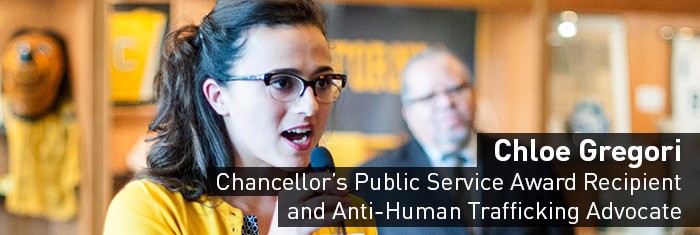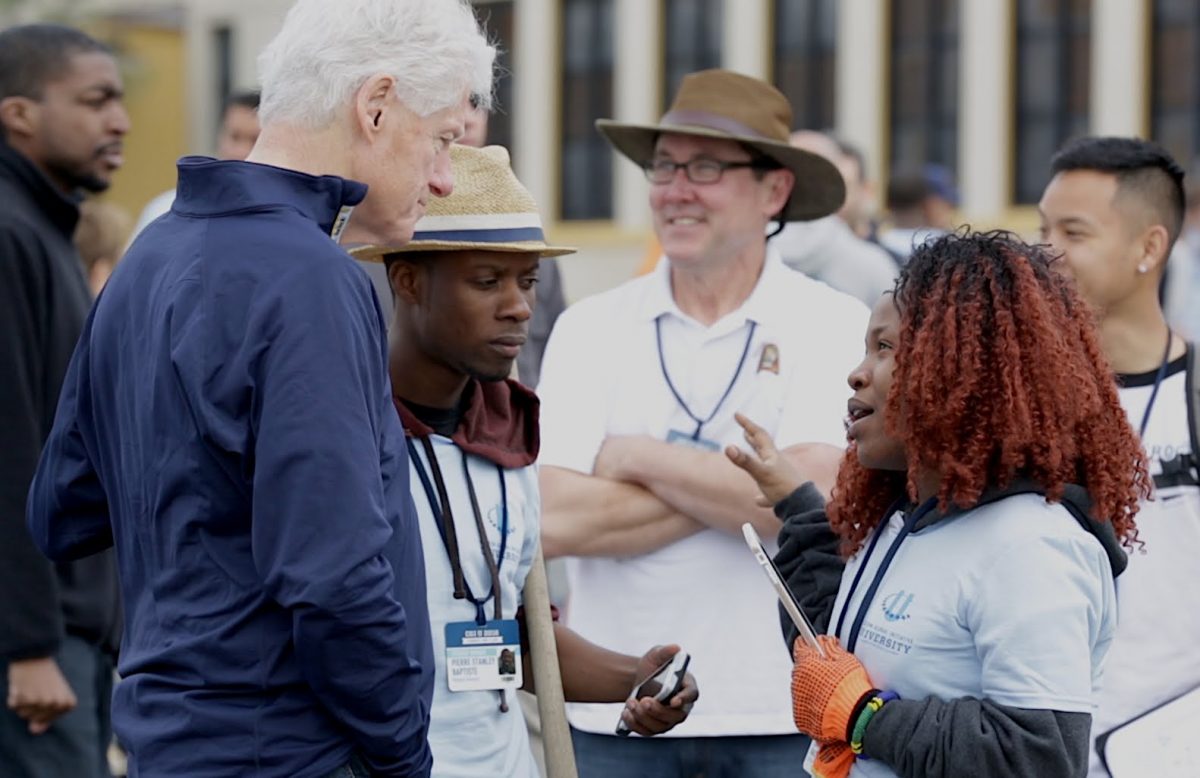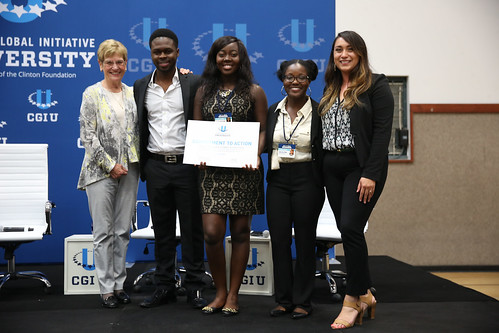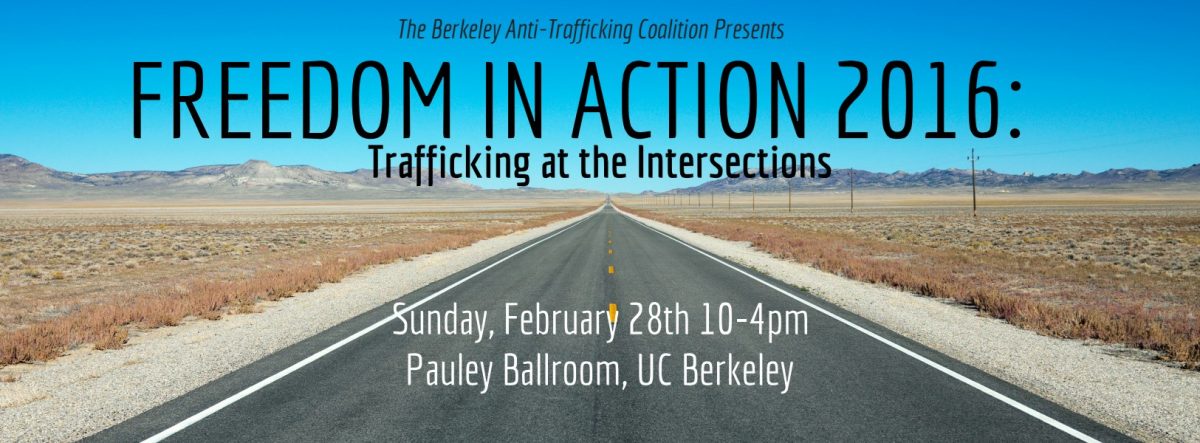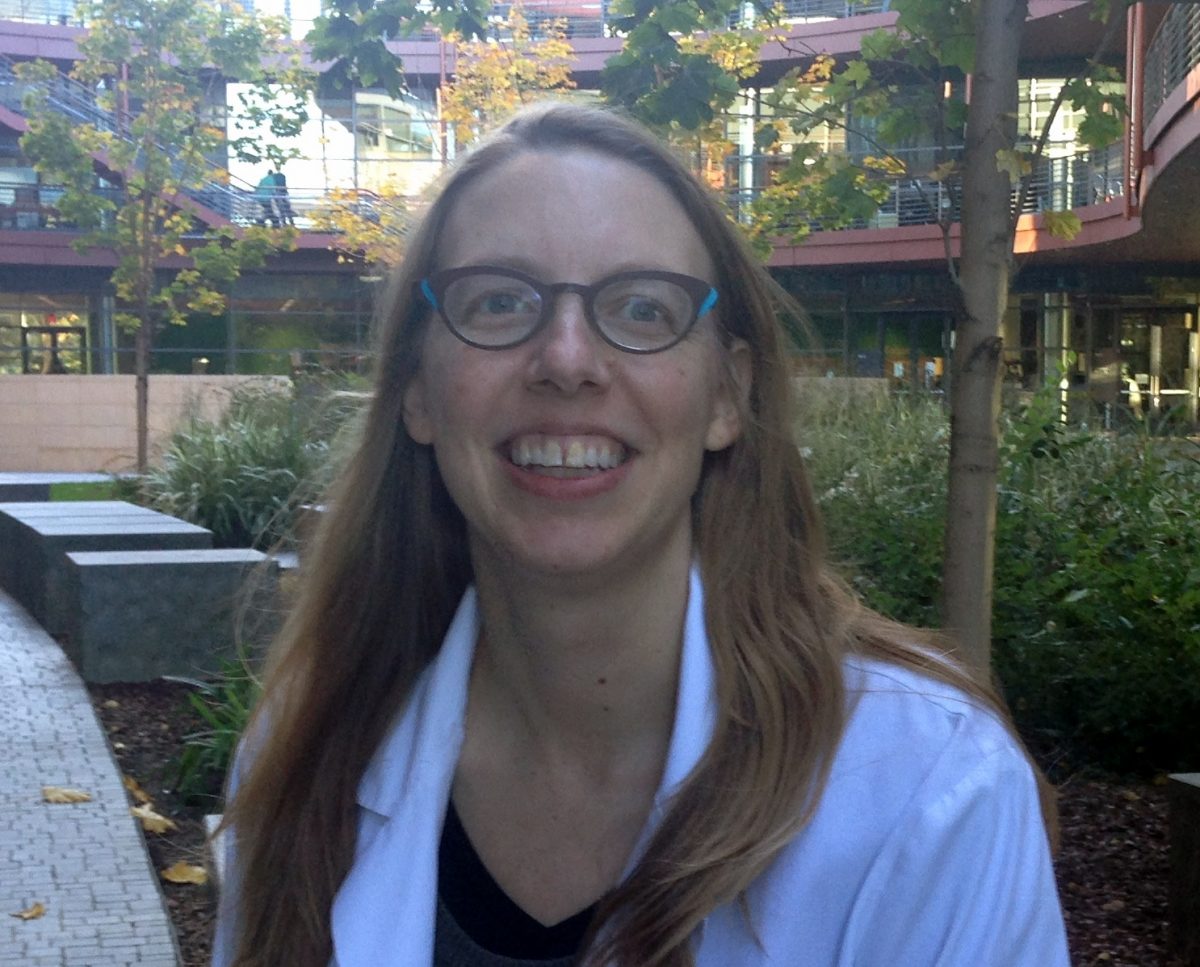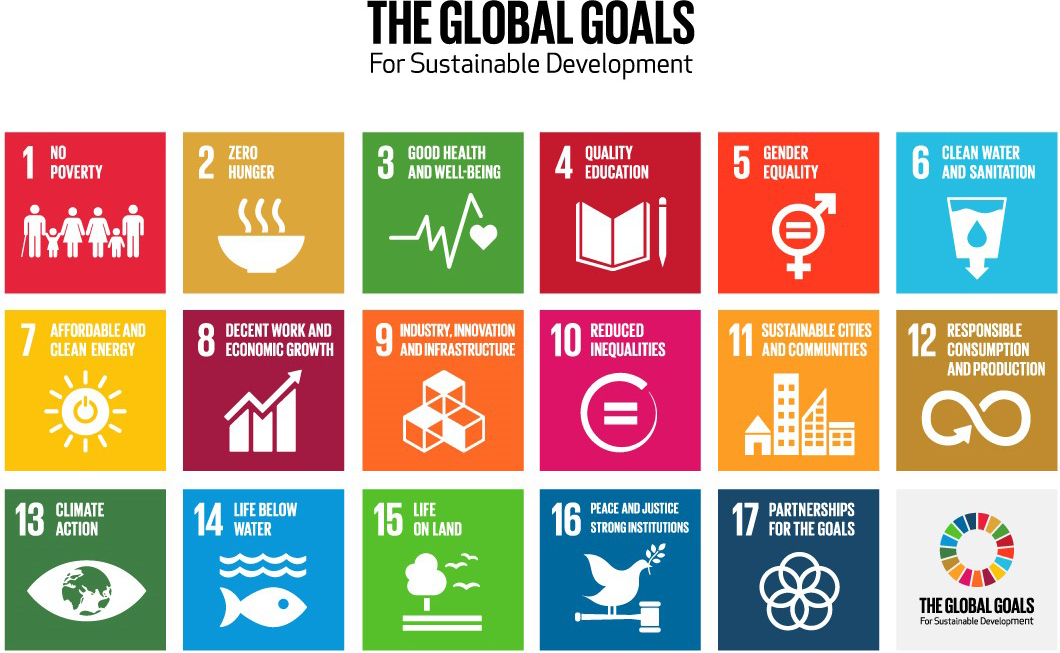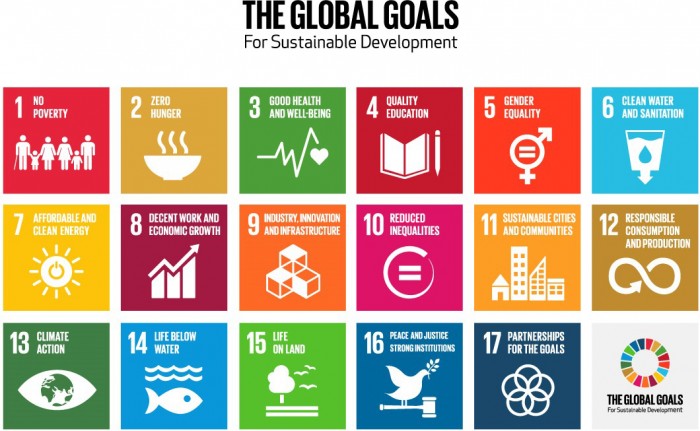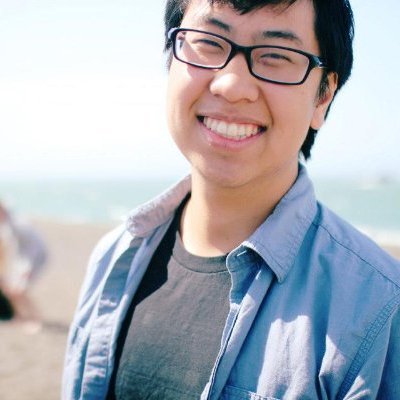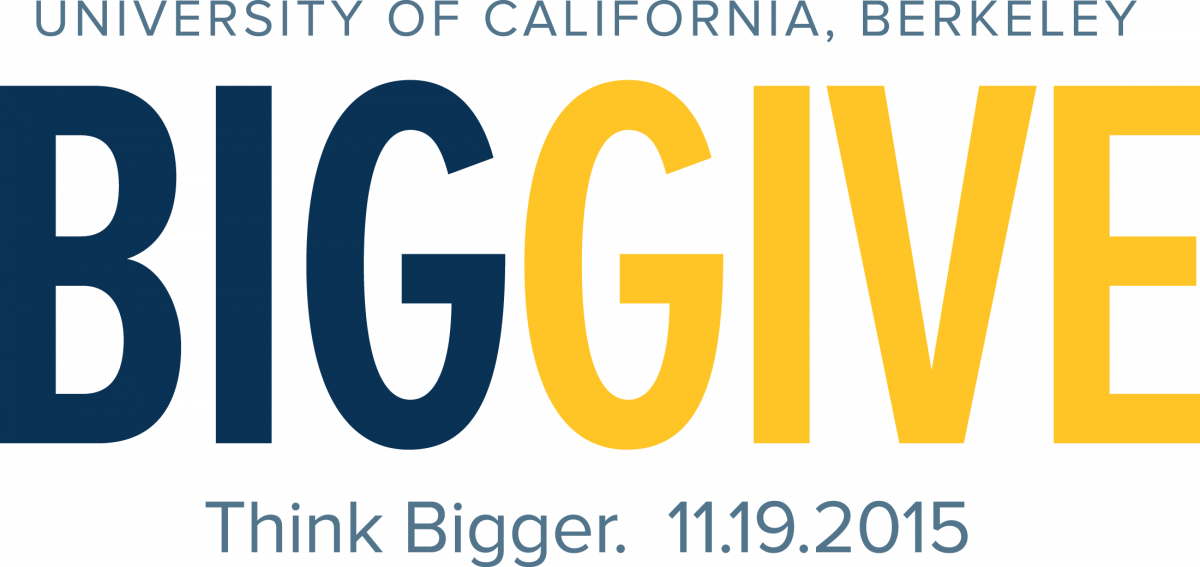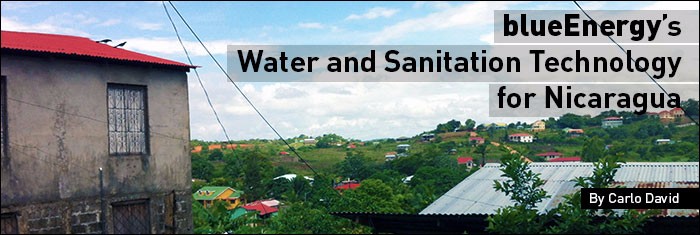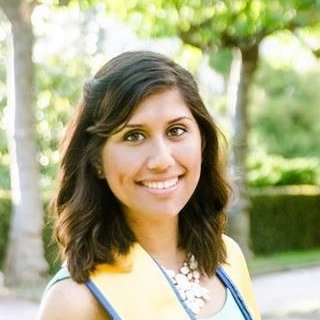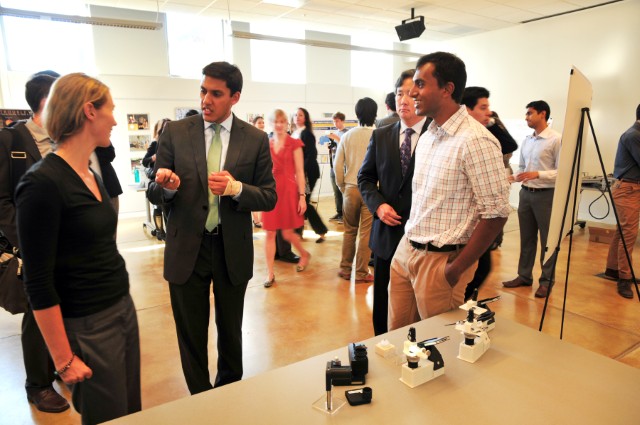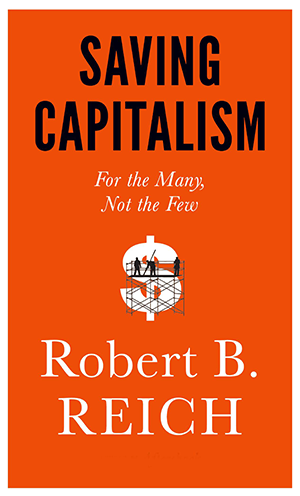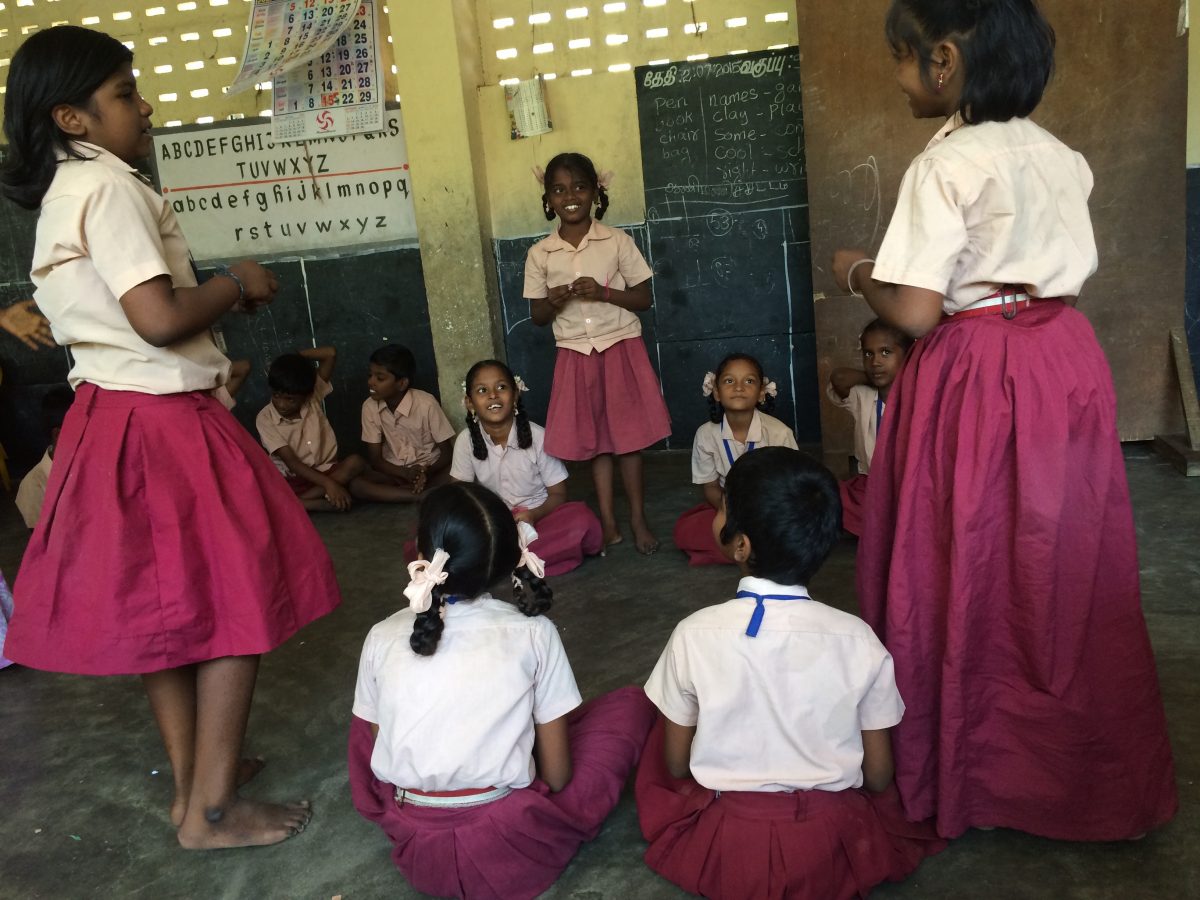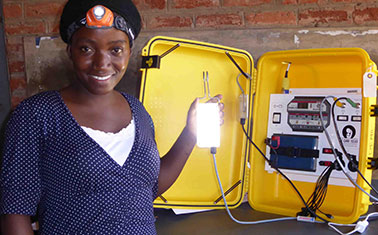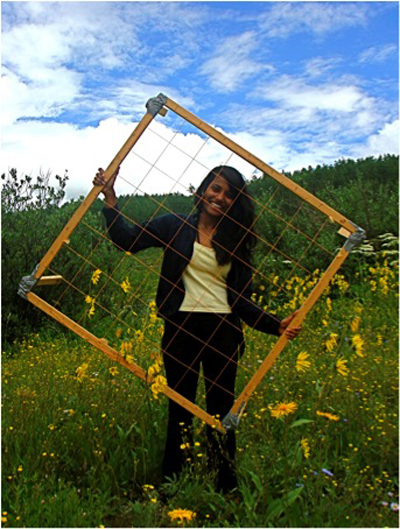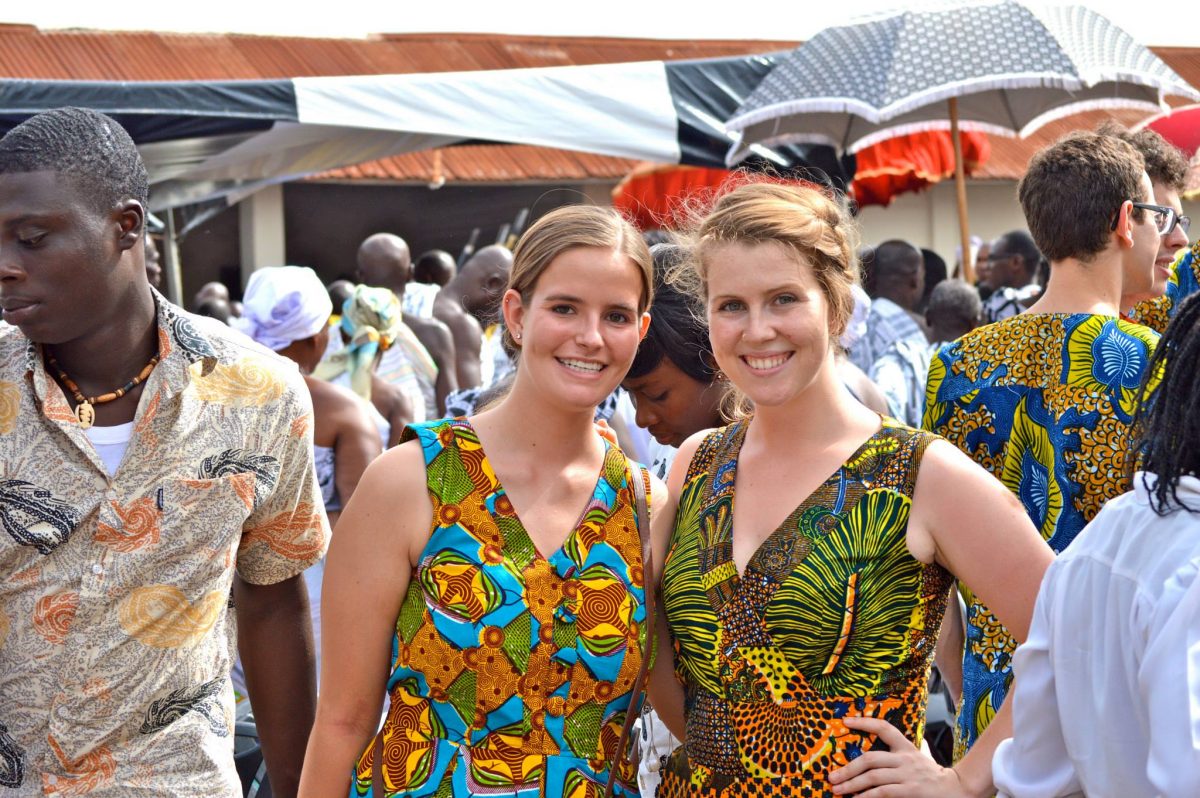Engineering in Solidarity: A Development Impact Lab Postdoc’s Reflection
Category: Blog
5 Questions with Liz Ogbu
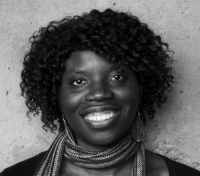
A designer, urbanist, and social innovator, Liz Ogbu focuses on sustainable design and spatial innovation in challenged urban environments around the world. Currently, she has her own multidisciplinary consulting practice that works with nonprofits, municipalities, and companies to tackle wicked social problems through creative transformations of places, systems, and communities. Her clients include the Nike Foundation and PG&E. In 2011, Ogbu was part of the inaugural class of Innovators-in-Residence at IDEO.org, IDEO’s sister nonprofit dedicated to fostering global poverty reduction through design and innovation. Prior to that, she was Design Director at Public Architecture, a national nonprofit mobilizing designers to create social change.
In addition to her practice work, Ogbu has had a long commitment to bringing social impact work into the classroom where her courses and research explore opportunities at intersection of design, innovation, and community engagement. She has taught at the California College of the Arts, the d.school at Stanford, and is a lecturer in the College of Environmental Design at UC Berkeley. Ogbu has written for and been profiled in publications such as Places Journal, Metropolis, Core 77 and the Journal of Urban Design. Her work has been exhibited at the Cooper-Hewitt National Design Museum, Rotterdam Biennale and Yerba Buena Center for the Arts.
Recently, Ogbu led a product design workshop at the Blum Center, funded in part by a grant from the Autodesk Foundation. She took some time to talk with us about how she became interested in design and social impact.
Q: When you started your training as an architect did you always think you’d gravitate to the impact design field or did you consider more mainstream architecture?
I’ve always looked at the social being inextricably linked with design. That’s why I’ve crafted my education and my career with that frame in mind. It’s interesting to note that in the early stages of my career, this kind of thinking was often considered separate from mainstream architecture. Now, more mainstream architects are increasingly looking in that direction. In other words, my way of engaging design is becoming more the norm.
Q: What influenced you to pursue a career in impact design? How do you think your work at IDEO.org has catalyzed your career?
Being raised by social scientists and having the freedom to design an architecture education that links design and social issues, helped to build the foundation for my career in impact design. My time at IDEO.org played an important role in my career. By the time I did the IDEO.org fellowship, I was already well ensconced in the field through the many years that I had spent at Public Architecture. IDEO.org enabled me to engage a broader understanding of design to look beyond architecture to the languages of product design, business design, etc. It was also helpful for teaching me the Human-Centered Design process.
Q: Top-down development approaches often face criticism for being non-participatory and even neocolonial. Much of your work is informed by ethnographies and interviews with the stakeholders you are trying to serve. Do you envision these methods spreading in the development sector? If so, why?
Yes, I think that more people are embracing the idea of focusing on the people at the heart of these problems. While there have been a variety of solutions applied to the most intractable problems over the last several decades that have generated some improvements, there have been many challenges that haven’t seen much movement. Clients (foundations, nonprofits, governments, and companies) and practitioners have been looking for deeper, more provocative solutions that can navigate these challenges. As a result, many have come to realize that the heart of many of these problems are the very people affected. Until we crack the nut of what is behind the needs, aspirations, and behaviors connected with the issues, we will never effectively solve them. For many of my clients, Human-Centered Design is a mechanism to move in this direction.
Q: The gender and race gap in the technology industry is well documented. Recent trends in the field of Development Engineering have tried to counter this. As a woman, person of color, and industry insider, what are your views on both of these trends?
It’s great that a light is being shined on these kinds of challenges. But the critiques haven’t gone deep enough. These are systemic issues and if we want to make changes at the systems level then we need to make systemic interventions. Adding diversity programs is not enough. There needs to be a critical awareness of why these issues exist and corresponding investments to address them. Ironically, some of the reasons why these issues exist are deeply personal. Racism, sexism, and bias have systemic impacts but are rooted in individual emotions. Figuring out how to have more authentic, vulnerable conversations is also critical to moving the needle.
Q: What advice would you give to students looking to follow in your footsteps?
The great – and sometimes maddening – aspect of this kind of work is that there is no direct path. My colleagues and I represent a variety of trajectories and skills. I think it’s important to figure out what you’re really good at and passionate about. Use that to help you understand where to dive deep. I also think it’s important to be entrepreneurial, whether at school or in the workforce. Take advantage of opportunities to expand your thinking, your network, and your training.
That being said, there are some academic programs focused on training people specifically around this kind of work, such as the Design Matters concentration at ArtCenter College of Design and the Master of Social Design at MICA (Maryland Institute College of Art). There are also some summer programs such as the Design Futures Symposium and post professional opportunities, such as the Rose Fellowship.
Chloe Gregori: Chancellor’s Public Service Award Recipient and Anti-Human Trafficking Advocate
By Nicholas Bobadilla
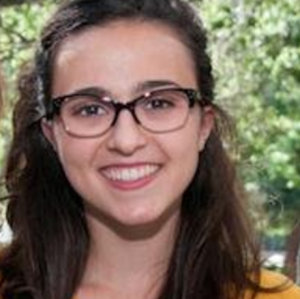 In 2012, UC Berkeley inherited the bright-eyed, intrinsically motivated, and socially-minded Chloe Gregori. This May she graduated as a Peace and Conflict Studies major, Minh Dang Fellow, Big Ideas winner, Global Poverty and Practice minor, and this year’s Chancellor’s Public Service Award recipient: the campus’s most prestigious public service award.
In 2012, UC Berkeley inherited the bright-eyed, intrinsically motivated, and socially-minded Chloe Gregori. This May she graduated as a Peace and Conflict Studies major, Minh Dang Fellow, Big Ideas winner, Global Poverty and Practice minor, and this year’s Chancellor’s Public Service Award recipient: the campus’s most prestigious public service award.
For the past four years, Chloe has cultivated her desire to promote social justice in the realm of human trafficking, a complicated issue that involves slave labor and forced prostitution, targets vulnerable populations like children and undocumented immigrants, and casts a shadow over nations across the world, including the United States.
Chloe’s journey began in high school when she discovered Not for Sale, a San Francisco non-profit dedicated to ending human trafficking. Inspired by the organization’s mission, Chloe started a chapter at her high school to promote awareness among her peers. Extra motivation came from her father, who encouraged her to watch a documentary that followed a 16-year-old sweatshop worker in China. The film widened Chloe’s perspective to include worldwide injustices, and cemented her passion for social advocacy. “It opened my mind that we live in an interconnected world, and that my everyday purchases were created at a human cost. This realization caused me to think about global inequalities, inspiring me to learn more and take action.”
Then came Berkeley, where Chloe arrived, as most freshmen do, flustered and overwhelmed by the thousands of opportunities scattered across Sproul Plaza and every building on campus. In her sophomore year, she joined Berkeley’s Not for Sale chapter. Her responsibilities focused on educational outreach, allowing her to spread awareness about human trafficking in Bay Area high schools. That year, Chloe also had a hand in combining the three anti-trafficking organizations on Berkeley’s campus into the Berkeley Anti-Trafficking Coalition.
At the start of her junior year, Chloe focused on expanding the reach of her work. Alongside her friends and fellow anti-trafficking advocates, Sarah and Hannah Singh, she entered the Big Ideas Competition. Hosted by the Blum Center, the contest gathers students to compete for funding to foster their social impact projects. Chloe and Sarah’s idea involved partnering with the Alameda County District Attorney’s office to reach out to Bay Area high schools and educate students about human trafficking. To expand awareness on campus, Chloe, Sarah, and Hannah hosted a decal to teach students about trafficking and match them with local high school students. The following semester, their involvement with the high schools would deepen, and, as mentors, they helped students create projects that promoted awareness about the issue.
A year of hard work competing against undergraduate and graduate teams from 20 universities across the country paid off when Chloe and Sarah’s project received honorary mention and was awarded $1000. Though the partnership with the District Attorney fell through, Chloe and Sarah led the DeCal, and ensured it remained true to its advocacy and mentorship goals. Now in its fourth semester, the class hosts speakers in the field to discuss their roles and actions students can take.
Aside from campus advocacy, Chloe also spent a summer working with an organization that combats child slavery in Ghana as part of her Global Poverty & Practice minor. “I chose my practice experience because I was interested in learning about human trafficking in a development context.” Founded by an impassioned survivor James Kofi Annan, Challenging Heights provides rehabilitation, preventative education projects, and community programs to combat child trafficking in the fishing industry on Lake Volta. Chloe was fortunate to spend time among the community, gathering stories and learning about the local side effects of trafficking. “I learned a lot by completing my practice experience in a developing country,” she said, “It was a transformative experience to begin understanding the vulnerabilities that perpetuate trafficking, and to learn from a grassroots organization doing meaningful and challenging work on the ground”.
But like many people engaged in this work, Chloe has had her moments of doubt. “Human trafficking is an extremely heavy issue and difficult to combat given its complexities. Honestly, it can be very overwhelming,” she said. “Sometimes I think, what’s the point?” She described a moment of acute apprehension, when she met a woman who led a job training program for trafficking survivors. After Chloe asked the woman to speak at a conference, she responded curtly, “I don’t want to do conferences. Girls are dying. We can’t just keep talking about it.” The exchange left Chloe to question the point of advocacy given the ongoing suffering for victims and the dire need for legal advocacy and social services.
Yet she overcame this hurdle, and was able to reconcile the importance of spreading awareness about the issue given its potential to spur people to action. “The conversation made me realize how important it is to stay connected to community organizations,” she said. “As much as we can talk about these issues, it’s crucial to include people in the conversation who work in the field and/or have been affected by injustice.” She is also motivated by the myriad opportunities available to tackle the issue. “I’ve learned that there are many intersections between human trafficking and other social issues. You can be in many different fields and combat trafficking in some way either directly or indirectly.”
That belief stuck with her, and this February, she served as the lead organizer of the “Freedom in Action” conference at Berkeley. Developed with the guidance of Chloe’s mentor and reputed anti-trafficking advocate Minh Dang, the conference gathered twenty anti-trafficking organizations, hosted 15 workshops highlighting anti-trafficking methods and outcomes, and fundraised for the SHADE Project, a survivor leadership organization in the Bay Area. The conference also included workshops for survivors of human trafficking, led by survivor leaders and advocates in the Bay Area.
Chloe was proud to see the advances she and her peers had made. “The conference allowed us to strengthen relations with organizations in the community,” She said. “Leading a group of people was really valuable, and I felt fulfilled when I saw committee members develop as leaders themselves through the planning and implementation of the conference.”
Her involvement with public service and her Global Poverty & Practice minor inspired a substantial shift in her attitude toward social justice. “In high school, I was more of a do-gooder. I didn’t think about my motivations or the implications of my work,” she said. “GPP made me think of the ethical complexities of ‘doing good’, what my motivations were, and what it means to work with rather than for a community.” All common revelations among GPP students, who are encouraged to think, question, reflect, and repeat, at the risk of paralysis, all for the sake of sidestepping the potential hubris associated with social justice work. (Full disclosure: your writer is a GPP minor.)
Chloe survived this phase and emerged wiser. “In GPP, we learned social change work is slow,” she said. “It’s the struggle of working together and working with people that makes it fulfilling and enjoyable, even given how difficult or frustrating these issues can be.” She’s been fortunate to spend time sharing this perspective and connecting with fellow GPPers in her role as an advisor in the Blum Center. “The Blum Center has provided a close-knit community of students who are engaged in international issues and public service,” she said. “These issues are challenging to combat, but being with people who share these common passions is inspiring.”
For now, Chloe has her sights set on fighting human trafficking in her local Bay Area. She hopes to begin that process in the nonprofit sector and expand upon her work as an undergraduate by spreading awareness through educational initiatives. “I see myself working in education. The first step of social change is awareness. If people, especially youth, become conscious of injustice and learn concrete steps to take action in their community, I think we are on the path to positive change.” Chloe also believes in the power of advocacy on a small scale: “It can also be a conversation with someone who didn’t know about human trafficking. Even these small interactions can make a difference over time.”
Chloe also draws strength from fellow advocates faced with similar doubts, frustrations, and disappointments, but made equally resilient by their ongoing struggle. “Just having people in the field who are doing incredible work is very inspiring.” That solidarity brings strength. “Being allies with survivors and survivor advocates is a way to cope with how challenging an issue it is.”
Our hats are off to you, Chloe. We can’t wait to see where your drive and dedication will take you next.
Big Ideas IT Finalists Put Apps to Work for Social Impact
Using Mobile Phones to Alert Households Waiting for “NextDrop” of Water (USAID Blog)
Dr. Aruna Uprety and the Fight Against Human Trafficking in Nepal
The American Himalayan Foundation (AHF) has joined with Dr. Aruna Uprety in her efforts to combat the trafficking of one of Nepal’s most vulnerable populations: young girls. Stop Girl Trafficking (SGT), founded by Uprety, has become one of AHF’s core programs in supporting the people and cultures of the Himalaya. Unlike many anti-trafficking programs, SGT focuses on prevention: preventing girls from being sold into brothels, forced into child marriages, or trapped into involuntary servitude by providing them with the means to stay in school.
According to Uprety, “Prevention is rescue without the suffering” because keeping girls in school and educating their communities about trafficking prevents young girls from being trafficked from the very start.
Uprety is the driving force behind SGT’s visionary approach. She visited the Blum Center on April 13, 2016, to share her incredible story and discuss the impact of Nepal’s April 2015 earthquake on her work. Bruce Moore, Regional Field Director of AHF, was on hand at the event to introduce Dr. Uprety and help her field questions.
Thousands of people were killed or injured in the earthquake. Many lost their homes and all their belongings. SGT and AHF mobilized quickly to help as many children and families as possible in the wake of the disaster. 3,800 girls were added to SGT’s existing roster of 11,000 girls and the program underwent an $840,000 expansion in order to provide services and resources to the local population. Workers and volunteers from SGT and AHF spent up to twelve hours a day assembling packages of food, clothing, sanitary pads, and other essentials that were distributed to the community.
Schools were closed after the earthquake and many families no longer had the money to pay for schooling. Local teachers reached out to SGT to step in during this difficult time. In response, AHF put up temporary buildings, and SGT helped thousands of children go to school. The impact of their work was profound. Uprety received countless letters including one from an eighth grader whose house collapsed in the earthquake. The girl was trapped under the house for two hours before her neighbors rescued her. Her family survived, but they lost everything, including all the materials the eighth grader needed to attend school. SGT was able to provide her family with the essentials they desperately needed. Because of their help, the girl was able to return to school.
Stories like these are the reason why Uprety continues to do her work. To date, not a single girl in SGT’s educational program has disappeared or fallen victim to trafficking. Uprety explains that the continued success of the program is dependent upon educating parents, students, teachers, and entire communities about how to spot traffickers and their techniques as well as the warning signs that a girl might be trafficked. Next steps include expanding the number of girls reached by the program and developing opportunities for continued higher education.
Currently, SGT focuses on educating girls up to the tenth grade, and AHF has piloted entrepreneurial and vocational training for graduates from Uprety’s program. AHF’s most recent partnership with the Federation of Business and Professional Women Nepal has been a standout success. The Federation’s Business Service Centre Project has empowered SGT graduates to start their own businesses. One participant opened her own computer academy that sells computer parts and provides technological education to the surrounding community. Another young woman started a successful textile company that sells items like scarves and sweaters. Other graduates from Uprety’s program have gone on to universities in places as far as Japan. Many have received full scholarships.
Beyond the academic and professional success of these former students, Uprety says that one of the best indicators of their program’s impact is the fact that many of the girls return after graduating to volunteer with SGT. It is this culture of community support that SGT believes will carry their work into the future.
About The American Himalayan Foundation:
The American Himalayan Foundation (AHF) is committed to helping “those in need who have no one else.” Concerned by issues of environmental degradation, the lack of basic health care as well as education, and the disappearance of traditional ways of life in the Himalaya, AHF endeavors to create “positive, tangible change” within the region. The organization helps hundreds of thousands of Sherpas, Nepalis, and Tibetans throughout the Himalaya each year by providing services and tools for education, health care, cultural preservation, and anti-human trafficking efforts.
Q&A with Glenn Yago
Solutions By Design: Development Engineering at UC Berkeley and the Autodesk Foundation
CGI U 2016: Videos of the Plenary Sessions
CGI U 2016: Committing to a Better World
By Nicholas Bobadilla
The campus was abuzz with excitement as over 1,200 students from around the world gathered at UC Berkeley for the Clinton Global Initiative University from April 1-3 to discuss and amplify their ideas for global change. In attendance were field experts, social entrepreneurs, and celebrities, including Kate Brandt, Google’s Lead for Sustainability; Obiageli Ezekwesili, Senior Economic Advisor of the Africa Economic Development Initiative; Salman Khan, Co-Founder and CEO of Kiva; Georgia Congressman John Lewis; and talk-show host Conan O’Brien.
This year’s CGI U attracted the largest group of students in its nine-year history, and was the first to raise over a million dollars in venture investments. To earn an invitation, students had to commit to a novel idea for change in local or global communities. “The price of entry is to commit to something,” said former President Bill Clinton. Participants committed to initiatives addressing climate change, poverty, public health and education. Among them were coding workshops for refugees, a comprehensive mental health curriculum pending as a bill in the Massachusetts State Legislature, and the use of drones to combat illegal poaching in Benin, Niger, and Burkina Faso.
Kicking off the conference was the Clinton Foundation’s Codeathon, an effort to leverage the technical skills of developers to develop technical solutions that promote health and wellness on college campuses. From Thursday afternoon to Friday morning, coders worked in teams to create platforms judged by Chelsea Clinton, Cisco’s Laura Quintana, and Kiah Williams of Supporting Initiatives to Redistribute Unused Medicine. Winners were announced at the closing plenary—tied for first were Quikko, an app that helps new students adapt to new college environments; and BeWell, which allows users to reflect and share their mental health challenges and experiences on a mobile platform.
Plenary sessions marked the beginning, middle, and end of the conference and involved remarks from social entrepreneurs, entertainers, and political figures who attested to the challenges and opportunities facing the crowd of young innovators. “We believe no one is ever too old or ever too young to make a difference,” said Chelsea Clinton in her opening remarks. “And that the earlier we start, the more likely we are to find the right partners for our efforts and have a better chance of making the positive difference we are called to do.” She pointed to the success of the Big Ideas @ Berkeley competition as an excellent example of how universities can support students trying to make the world a better place.
Former President Bill Clinton kicked off the conference with a theme that threaded throughout the weekend. He emphasized the urgency of climate change, global terrorism, and economic inclusion, yet he expressed confidence in efforts to counteract these problems. “It’s an exciting time to be alive, but it’s a constant race between positive interdependence and the forces of negative interdependence.” Backing his faith in the CGI U mission, he conveyed a sense of hope in students’ potential to make the world better. “Every time I see you, I become convinced that the positive forces will win.”
Additional topics at the forefront of the weekend’s plenaries included efforts to build inclusive communities as well as the “unintended consequences” of social impact work. Tied deeply within these conversations was the value of failure on the path to success. “Beyond every failure is an insight that can lead you to success,” said Catlin Powers, Co-Founder and CEO of One Earth Design.
Unintended consequences, according Dr. Powers, should be leveraged to support communities, who should be made an integral part of any social impact project. “Listen to the communities you’re allying yourself with,” said comedian and disability advocate Maysoon Zayid. In support of that mission, Zayid encouraged the audience to forge alliances with opposition groups, as finding commonalities is the best way to create sustainable and universal change.
Throughout the day, students attended working sessions focused on topics that spanned educating refugees during a crisis, developing a more sustainable economy, and boosting diversity and inclusion on college campuses. Students gathered before entrepreneurs, university officials and fellow students. A standout remark from Falkora co-founder Khaliya offered advice to prospective social entrepreneurs during a session dedicated to dismantling stigmas around mental health: “Starting a social enterprise doesn’t make me a social entrepreneur,” she said. “Social entrepreneurship is a mindset and thought process.” 
Following an impassioned speech on the durability of public education by UC president Janet Napolitano, audiences were treated to an interview between comedian Conan O’Brien and Bill Clinton, who again touched on his hope for the coming generation of change-makers. “They are the most poised to make change, because they ask the ‘how’ question.”
In support of CGI U’s commitment to community service, the conference ended with a Day of Action, led by President and Chelsea Clinton, who partnered with the Oakland Unified School District and Oakland Public Education Fund at the Havenscourt and Lockwood Campuses in Oakland. Students worked with community organizations to improve the area around campus by planting trees, organizing libraries, and painting murals. Also in attendance were UC Berkeley alum and NFL All-Pro and Co-Founder of Fam 1st Family Foundation, Marshawn Lynch, and Oakland mayor Libby Schaaf.
As much as the conference focused on pragmatism, participants were sent off with calls to commitment and passion. Premal Shah, Co-Founder and President of Kiva offered this advice: “First, design for love, then figure out how that can be scalable.” Congressman John Lewis advocated for a stance shaped by devotion and gratitude: “Stand up for what’s right and just,” he said. “Live a life of hope and be happy doing so.” And in his closing remarks, President Clinton reiterated what was perhaps the conference’s prevailing theme: “We can’t build a perfect world, but we can build a better world.”
A Course that Designs for Sustainable Communities
Berkeley to Host 2016 Clinton Global Initiative University
By Nicholas Bobadilla

From April 1st through 3rd, students, university representatives, policymakers, and topic experts from around the world will convene at Clinton Global Initiative University (CGI U), a three-day conference hosted by the Clinton Foundation that allows students to jumpstart and share innovative ideas for global change. Since 2007, CGI U has spurred thousands of change-makers to pledge their “Commitments to Action” in one of five focus areas: education, environment and climate change, peace and human rights, poverty alleviation, and public health. “Making a public commitment enhances personal accountability,” says Thato Keineetse, one of dozens of Cal students chosen to participate in the event. Former President Clinton and Chelsea Clinton will oversee the ninth edition of CGI U at UC Berkeley, which will host undergraduate and graduate students seeking to make the commitments that will usher their projects to completion.
The conference will include opportunities to exchange ideas, develop partnerships, network, and apply for funding to launch or expand projects. Universities in the CGI network must pledge at least $10,000 in support to participants, meaning over $750,000 will be made available for students to convert their ideas into action. Since 2008, CGI U participants, formally known as “commitment-makers,” have received $2 million in funding support and have made over 5,500 Commitments to Action. The conference will end with a Day of Action, in which students participate in a community-wide service event alongside local nonprofits or community organizations. This year, commitment-makers will work with Havenscourt Campus in East Oakland, a shared campus of four schools in the Oakland Unified School District that serves over 1500 students. Activities will include urban agriculture, mural painting, leveling books for the library, and cleaning the athletic facility.
CGI U participants undergo a competitive selection process. This year, Cal’s participants are engaged in projects ranging from 3D printing to microfinance to lobbying for LGBTIQ+ legislation. Find out more about them below.
Michelle Nie will employ the skills she has developed as a Business major to launch Māk, a social enterprise that empowers low-income youth by training them to design 3D printed products. Through an intensive, skill-building boot camp, the youth will learn to use 3D printing software. They will then work as interns for Māk, creating consumer products to be sold through the enterprise’s e-commerce website. Profits will be reinvested in future cohorts and more resources. Nie founded Māk alongside fellow business majors Ankita Joshi and Aubrey Larson, who started it as a project for a Social Entrepreneurship course. “I’m excited to learn about the amazing projects my Berkeley peers are working on and to connect and collaborate with students from around the globe,” said Nie.
MBA student Thato Keineetse’s Mo’H2O is committed to alleviating energy poverty and water scarcity in sub-Saharan Africa by making sustainable clean technology solutions more affordable. Mo’H20 will assemble, distribute, lease and service integrated solar water pump systems for low-income smallholder farmers in East and Southern Africa. Using an innovative business model, Mo’H2O will make it easier for people to pay for clean technology, while benefiting from increased productivity driven by a constant supply of water and access to cheap and reliable energy. “I’m excited to meet, share ideas, and work with others who have taken this step to transform their ideals into actions,” said Keineetse.
Big Ideas Finalist and MBA student Sneha Sheth seeks to give low-income mothers in India a leg up on their children’s development and educational readiness via an automated voice call service called Dost. The service provides a mobile platform that combats illiteracy by empowering mothers to deliver early learning experiences to their children. In giving mothers activities that fit into their daily routines, Dost represents a simple, innovative method of cultivating the potential of low-income Indian children. Sheth believes education to be the best way to alleviate poverty.
MBA student Zoe Beck will partner with UC Berkeley to produce and distribute a new MOOC on economic inequality. Former Secretary of Labor Robert Reich will teach the course, which will explore the ongoing economic inequality in the United States, its impacts on the nation’s economy and democracy, and what can be done about it. Intended to inform and engage, the course will feature filmed lectures as well as live interactive forums, and will emphasize steps students can take to make a difference.
Dedicated to alleviating poverty in the Bay Area through financial inclusion, Amanda Ng will work with a technology start-up called Insikt to find banks, insurance companies, retailers, and other businesses in Berkeley and Oakland that target low-income consumers whose credit histories make them ineligible for loans. Ng will lobby businesses to use Insikt’s lending platform, which employs an underwriting algorithm to assess the creditworthiness of potential borrowers, and determines a loan size and interest rate that maximizes repayment rates. Insikt’s efficiency in gauging financial potential, along with its current array of partners, make it a viable and accessible method of building capital among the poor.
Clintons, CGI University at Berkeley this weekend (UC Berkeley News)
Blum Faculty Isha Ray Publishes “Towards Gender Equality through Sanitation Access,” a Discussion Paper for UN Commission on the Status of Women
http://prod.unwomen.org/en/digital-library/publications/2016/3/towards-gender-equality-through-sanitation-access
Hombres Verdaderos: Training Youth to Confront Domestic Violence
Cal Bears in the Fight against Trafficking
By Sarah Bernardo
At a university with a long, illustrious history of social activism, it is easy for students to feel overwhelmed by the sheer number of movements and awareness campaigns being waged on the UC Berkeley campus. Certain issues seem to fall through the cracks. A dedicated group of Cal students is working hard to make sure that human trafficking does not become one of those overlooked issues.
According to Apurva Govande, the Co-President of the Anti-Trafficking Coalition at Berkeley, sex trafficking, child labor, forced labor, and bonded labor are not isolated issues, but “human issues” that touch every aspect of our daily lives from the clothes we wear to the food we eat.
While the anti-human trafficking community at Cal is small, interest in the issue has been growing rapidly. The Anti-Trafficking Coalition is taking a big step to grow awareness on trafficking and modern slavery by hosting their second “Freedom in Action” conference this Spring (on Sunday, February 28).
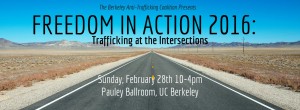
The conference is open to everyone, and this year’s theme is “Trafficking at the Intersections.” According to Kathy Brasil, the Coalition’s Publicity Chair, “we will be exploring many nuances of slavery and freedom through a keynote address from survivor and Cal alum Minh Dang as well as a number of unique workshops.” Dang is the founder of the Minh Dang Fellowship for Human Rights which focuses on the eradication of all forms of modern slavery. (The application for the fellowship is open to all UC Berkeley students, and one student is selected each year to serve as a Dang Fellow.)
Govande said, “As student abolitionists, we can often make a much greater difference than we realize. Just being aware of the issue can catalyze change for the people behind the issue: the men, women, and children that human trafficking directly affects.”
Dedicated anti-trafficking activists at Cal have been busy developing programs like the Human Trafficking Prevention Education DeCAL, which Govande says “does a great job of familiarizing students with the issue and brings in speakers each week that highlight different aspects of human trafficking.”
The Anti-Human Trafficking IdeaLab is another result of activist efforts. The IdeaLab is a multidisciplinary think tank that brings together students, academics, and community partners to tackle human trafficking. Their aim is to analyze the intersecting social issues that contribute to modern slavery and to present best practices for combating the issue at its source. No particular experience is necessary, so anyone with an interest in human trafficking is encouraged to join the IdeaLab.
This Spring at the Blum Center, world-renowned anti-trafficking activist and expert Siddharth Kara is teaching Global Poverty & Practice 140, “Human Trafficking and Modern Slavery.” (Read our interview with Kara here.) GPP 140 is an eight week course that examines various modes of exploitation within numerous contextual frames such as economics, culture, and history.
The renewed energy and attention on trafficking got a huge boost at Cal in 2013 when the Student Abolitionist Movement, the UC Berkeley chapter of the International Justice Mission, and Not For Sale combined to form the Anti-Trafficking Coalition at Berkeley. Brasil describes the coalition as a “student-run organization that focuses on educating students, raising awareness in the community, and advocating for more effective legislation in order to eliminate human trafficking in the Bay Area and beyond.”
Although the Human Trafficking Prevention DeCAL and GPP 140 are indications of increased awareness and interest, Russell Wilson, a former member of the Student Abolitionist Movement and advisor to the Coalition, says, “I would like to see more DeCALs as well as actual full credit classes taught on human trafficking. One thing that would be good is if a department such as the Social Welfare department would hire a person with both an academic and anti-trafficking background to create a curriculum around human trafficking.”
The “Trafficking at the Intersections” conference will feature a host of events to engage people who are new to the issues of human trafficking, as well as seasoned activists. Twenty different workshops will be offered, covering a range of topics including “Human Trafficking and the Superbowl Myth,” “Healing Through the Expressive Arts,” and “The Intersection of School-to-Prison Pipelines and Human Trafficking.” Legal professionals and academics such as Alameda County’s Deputy District Attorney Sabrina Farrell; Director of the Boalt School of Law Anti-Trafficking Project Alynia Phillips; and Federal Administrative Judge Marianna Warmee will be leading workshops. Representatives from non-governmental organizations, arts groups, and religious communities like CEO of Breaking the Chains Debra Woods and Reverends Amy Zucker Morgenstern and Debora Pembrook from the Unitarian Universalist Abolitionists will also host sessions.
In whatever way individuals choose to join the anti-trafficking community at Cal, they will be met with passionate and driven advocates. Govande, Wilson, and Brasil emphasize that the reason to become a part of this movement is that human trafficking is something that affects us all.
How Can You Get Involved?
Freedom in Action Conference 2016: Trafficking at the Intersections
Sunday, February 28 from 9:00 am to 4:00 pm
Grand Pauley Ballroom at UC Berkeley
The Anti-Trafficking Coalition at Berkeley meets every Monday 7:00 pm to 8:00 pm in 175 Barrows
Human Trafficking Prevention Decal
“Are These Kinds of Things Still Happening?” Siddharth Kara on Human Trafficking and Modern Slavery
By Sarah Bernardo
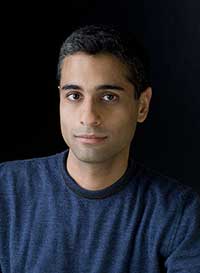 Siddharth Kara is a world-renowned expert on human trafficking and modern slavery. He lectures at both Harvard University and UC Berkeley, and advises the United Nations, the U.S. government, and many other governments, foundations, and NGOs on anti-trafficking policy and law. Kara is also the author of two books, the award-winning Sex Trafficking: Inside the Business of Modern Slavery and Bonded Labor: Tackling the System of Slavery in South Asia.
Siddharth Kara is a world-renowned expert on human trafficking and modern slavery. He lectures at both Harvard University and UC Berkeley, and advises the United Nations, the U.S. government, and many other governments, foundations, and NGOs on anti-trafficking policy and law. Kara is also the author of two books, the award-winning Sex Trafficking: Inside the Business of Modern Slavery and Bonded Labor: Tackling the System of Slavery in South Asia.
This semester, Kara is a lecturer at the Blum Center, teaching Global Poverty & Practice 140, “Human Trafficking and Modern Slavery.”
You first witnessed human trafficking the summer after your junior year in college while at a Bosnian refugee camp. You later went on to work as an investment banker and head your own consulting firm. What made you decide to return to the issue of human trafficking?
I had always been heavily impacted by that summer in the refugee camp, and at the time I was just too young to really process the experiences. So it was some years later when I was reflecting on the course of my life that I returned to the issue. I had worked in investment banking and learned quite a bit about the world of finance and economics. But I had always been affected and haunted by that summer. I was curious: are these kinds of things still happening, and if so is anyone doing anything about it? This was the late 90s, and I didn’t see much in the way of research. There were one or two narrative reports, but nothing analysis-based. So I thought, if I’m ever going to try something like this in my life, now is the time. I didn’t have formal training in human rights research, but I had a sense that this was an economic crime and that maybe I could make a contribution. I took my first research trip in the summer of 2000 across East Asia and Central Europe. The things I saw really overwhelmed me, and from that point I became dedicated to trying to understand and tackle the issue.
What is your opinion on the current state of human trafficking research and education?
The current state of human trafficking research and education is leaps and bounds ahead of where it was when I started my research almost 16 years ago. There are actually classes that you can take on the subject. There are books that have been written. Numerous research projects and reports are being conducted by researchers, NGOs, governments, foundations, and the UN. Having said that, there is still a tremendous research gap. The field suffered across the entire decade of 2000 to 2010 from not having sufficient focus on data gathering to understand the issue. For many years, there was a lack of credibility and legitimacy in anti-slavery work as a result of this deficiency. But that is changing now. There is more research being done, however there is still a significant data gap on human trafficking and slavery around the world.
When you are in acting in an advisory role for NGOs or governments, what is the most difficult aspect about addressing trafficking?
It’s very different depending on whether it’s a government or a non-government organization. With governments, much of my interaction has focused on a handful of challenges. One can be that they are generally in denial that their country has a significant issue or an issue at all with human trafficking. If they recognize that they have an issue, they want to frame it as an irregular migration problem and deal with it from a migration standpoint as opposed to a human rights and forced labor standpoint. They may not have enough data or information to guide their policy, or they may be reluctant to allocate the kind of resources that are required to address the issue both from a law enforcement standpoint and also from a victim empowerment and protection standpoint.
With NGOs, they have the passion and the courage to tackle the issue, but they may suffer from not knowing how to do research or how to measure the impact of their projects, which is very important from a donor standpoint. Data gathering and research is crucial to donors there days, and while NGOs are often in the best position to do this work, they may not necessarily be equipped or trained to do it.
There are also a handful of major obstacles to the successful punishment of human traffickers. One is there is a lack of systemic law enforcement focus on the issue. Two, there is a lack of understanding and training in how to identify traffickers. Three, there is a lack of protection and empowerment of victims who are crucial as witnesses to give information on traffickers and trafficking networks.
Do you think a capitalist economic system can ever coincide with the abolition of modern slavery?
I think so. I think market economy principles and economic globalization have to be recrafted into being a slightly more equitable system for all participants and non-participants, but that’s doable if world leaders want to achieve those goals. I think that will go a long way towards ridding the world of many of the push and pull factors that motivate trafficking and forced labor.
You are working on a film adaptation of your award-winning book Sex Trafficking: Inside the Business of Modern Slavery. What is your vision for the film?
I wrote the script for the film. I adapted many real world cases from those that I documented for my first book and from research that I’ve done since then to tell the first truly global and authentic feature film story on human trafficking. It tells the stories of three young women. One is from India, one is from Nigeria, and one is a foster care child in California. You follow their journeys of being trafficked around the world to the same place in Texas, along the way covering Europe and Latin America. The film spans the world because the issue is a global phenomenon, but the film is set here in the United States because the story of domestic human trafficking is remarkably under-discussed. You hear a lot of stories about trafficking in Cambodia, Nepal, India, Moldova, Nigeria, and Mexico, but not so much the United States. That’s starting to change, and I hope that this film sparks a conversation about the human trafficking problem right here in the U.S.
I hope the film will serve as a vehicle for generating new energy and resources to tackle human trafficking here and around the world. In support of these efforts, I will be doing several major events with the film with the UN and several governments around the world as well as NGOs to raise awareness and channel resources where they are needed. It will also have a theatrical release to touch the general audience. It has some fantastic stars in the cast, and I’m really looking forward to its release later this year.
How can average citizens contribute to the fight against modern slavery?
The first thing the average person can do is learn more about the issue by reading books and watching documentaries or films. The more you know the more effective you can be.
Two, spread that knowledge. Raise awareness among your peer groups, friends, co-workers, etc. That is a very tangible thing that people can do.
Three, support an NGO that works on this issue in some way. It could be financially or through volunteer work. It could be to help raise resources so that they can scale their efforts. Supporting anti-trafficking NGOs in some capacity is very important.
Four, engage with elected officials on the issue. Demand that they do more both from a sex and labor trafficking standpoint. In particular, on the labor trafficking side, one of the main areas of focus in the field now is how human trafficking, slavery, and child labor taint global supply chains of the things we purchase every day. I think people can get engaged in demanding that lawmakers set regulations for companies to ensure that their supply chains are untainted.
My report “Tainted Carpets: Slavery and Child Labor in India’s Hand-Made Carpet Sector” was the first major commodity-based investigation of slavery and child labor in the production phase of a commodity. It showed a model of how to do that kind of research and how to trace the products from the point of production to the point of retail sale. It showed you can get a sufficient sample size in cases documented to express prevalence rates of slavery and child labor in the supply chain. It made recommendations about how to clean up the supply chain. Ideally, one would do a series of commodity-based investigations and reports like that. I have a long list that I would like to do such as seafood, conflict minerals, garments, tea, coffee, cocoa, rice, and palm oil.
Five, use all the tools we have today like social media and communication to keep energy and momentum going so that you don’t have people getting excited and working on an issue for a while and then fading into something else. It’s important to use tools to keep people engaged, energized, and motivated.
Blum Center Receives First Higher Education Grant from Autodesk Foundation
Blum Center News
 February 1, 2016—As part of its investment focus on supporting people and organizations using design for impact, the Autodesk Foundation has awarded UC Berkeley’s Blum Center for Developing Economies one of the Foundation’s first university grants.
February 1, 2016—As part of its investment focus on supporting people and organizations using design for impact, the Autodesk Foundation has awarded UC Berkeley’s Blum Center for Developing Economies one of the Foundation’s first university grants.
The Blum Center is among four higher education institutions—including the Srishti Institute of Art, Design and Technology (Bangalore, India), Olin College (Needham, Mass.), and the Art Center College of Design (Pasadena, Calif.)—to be recognized for their impact design ecosystem.
Impact design is rooted in the core belief that design can be used to create positive social, environmental, and economic change, and focuses on actively measuring impact to inform and direct the design process.
“The Autodesk Foundation looked at hundreds of colleges and universities around the world engaged in impact design,” said Lynelle Cameron, president and CEO of the Autodesk Foundation. “We chose these four institutions for the strength of their programs and the diversity of their approaches. The Blum Center appealed to us because of its emphasis on human-centered design and experiential learning. We appreciate that the Blum Center’s impact design process relies on interdisciplinary collaboration for achieving breakthrough ideas and inventions.”
The gift will facilitate new courses and student initiatives that promote and support impact design. In particular, the Blum Center will launch a “Hardware for Good” challenge in its highly regarded student innovation competition, Big Ideas@Berkeley. Since its founding in 2006, Big Ideas@ Berkeley has inspired innovative and high-impact student-led projects aimed at solving problems that matter to this generation. The contest has sourced hundreds of innovations, and supported thousands of problem-solvers who have gone on to launch nonprofits, for-profits, and cross-sector partnerships that are scaling solutions across the globe.
In addition, the Blum Center will initiate a new project-learning track for students in the Development Engineering program. Development Engineering is an emerging field preparing the next generation of development practitioners totake an integrated approach to develop sustainable solutions. Utilizing human-centered design approaches, engineering expertise, and an economic framework, this emerging field combines cross-cultural learning, novel financing mechanisms, prototyping and scaling, rigorous evaluation, and new models for productive international collaboration.
“We are thrilled to be partnering with the Autodesk Foundation to support students and faculty who want to make a difference,” said Maryanne McCormick, executive director of the Blum Center. “Today’s greatest challenges require the expertise and collaboration of every possible field. A key ingredient of success is impact design, enabling more innovative, scalable, and measurable solutions.”
The Autodesk Foundation is the philanthropic arm of Autodesk, a multinational corporation that makes software for the architecture, engineering, construction, manufacturing, media, and entertainment industries. The Blum Center enables interdisciplinary problem-solving aimed at poverty alleviation and social impact, operating on the notion that a world-class, public university must be a force for addressing urgent and important issues. Since its founding in 2006, the Blum Center’s mission has been to train people, support ideas, and enable solutions.
“If we want more people using the power of design to address today’s epic challenges, we need to equip future designers and engineers with the skills, knowledge, and tools to do so,” said Joe Speicher, executive director of the Autodesk Foundation. “We chose to support the Blum Center for Developing Economies because of their success as an interdisciplinary hub for social impact studies and action that prepares the next generation of change agents.”
Development Engineering: Reflections from a Development Impact Lab Postdoctoral Fellow
http://dil.berkeley.edu/development-engineering-reflections-from-a-development-impact-lab-postdoctoral-fellow/
Transforming Maternal Healthcare in Kenyan Slums
Five Questions for Development Engineer Rachel Gerver
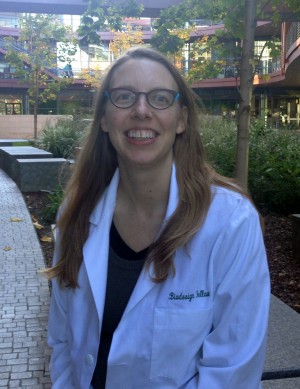
Rachel Gerver is among the first generation of UC Berkeley students in Development Engineering, a growing field for graduate students focused on technological solutions for low-income regions. Gerver graduated from UC Berkeley in 2014 with a PhD in Bioengineering, where she investigated the application of Herr Lab technology for rapid point of care HIV monitoring and infant diagnosis in Kenya. She currently serves as a Biodesign Innovation Fellow at Stanford University, identifying unmet needs in medicine at hospitals and clinics and assessing the market size and competitive landscape for potential new medical devices. The Blum Center sat down with Gerver to learn more about her background and interests.
What were your career plans when you started your PhD and how did they change?
When I started the PhD in Bioengineering at UC Berkeley/UCSF, I thought I would pursue a career in academia and become a tenured professor. About halfway through the program, I realized that I was much more motivated by applied projects and helping to get new medical technologies to market, where they can have an impact on patients’ lives. I also became even more interested in how new technologies can help improve access to medical care for underserved populations.
What was the nature of your Development Impact Lab Explore Grant?
I received a DIL Explore grant to travel to Kenya and work with Family AIDS Care and Educational Services (FACES) to understand whether [Amy] Herr Lab technology could be applied to early infant HIV diagnosis. I spent time in the Nyanza province of Kenya, including Mbita, Kisumu, and Mfangano Island. I learned the importance of understanding the overall system in assessing what technologies can have an impact, and in particular the challenges of supply chains and logistics in bringing medical care to underserved regions.
What is exciting about the medical technology field?
The rapid growth in the medical technology space and the potential of new fields, including mobile technologies, big data, and genomics, to improve human health and access to healthcare around the world.
Where do you see yourself in five years or 10 years?
Continuing to work on technologies that can enter the market and improve human health around the world.
Who are the scholars or practitioners you most admire?
I greatly admire organizations that have worked to get new technologies into the market to improve access to healthcare in underserved populations, including PATH and D-Rev. I also admire physicians such as Paul Farmer, who have devoted their careers to improving global health from the field and inspiring others to do the same.
The Somo Project: Learning Lessons in Kibera
The Blum Center and the Sustainable Development Goals
By Sybil Lewis
On September 25, 2015, the United Nations adopted the 2030 Agenda for Sustainable Development, establishing the Sustainable Development Goals (SDGs) to end poverty, hunger, and inequality worldwide.
The robust set of goals was formulated and agreed to by 193 countries and represent, said UN Secretary-General Ban Ki-moon, “an agenda for people to end poverty in all its forms—an agenda for the planet, our common home.” Also known as Global Goals, the SDGs comprise 17 goals and 169 targets, such as Clean Water and Sanitation, Gender Equality, and Climate Action.”
The Sustainable Development Goals replace the UN’s Millennium Development Goals (MDGs), which were established by world leaders in September 2010, along with a 15-year agenda to tackle similar issues including poverty, hunger, and child education. According to a 2015 UN report, the MDGs “produced the most successful anti-poverty movement in history,” reducing the number of people living in extreme poverty by more than half and achieving gender parity in primary schools in almost all countries.
While the MDGs were successful, progress has been uneven across regions and countries. Shortcomings remain in many target areas, such as climate C02 emissions that have increased by over 50 percent since 1990 and the fact that over 160 million children under age five have an inadequate height due to malnourishment.
The idea of the SDGs emerged at the 2012 Rio+20 meeting, where the dimensions of sustainable development were identified as environmental, social, and economic—thus broadening definitions of international development beyond economic indicators. Furthermore, the MDGs laid out eight goals for developing countries, while the SDGs acknowledge that sustainable development cannot be achieved unless all countries participate.
Since its founding in 2006, the Blum Center for Developing Economies has supported people and projects working to achieve several of the SDGs. Through the Development Impact Lab and the Big Ideas@Berkeley competition, the Blum Center has trained and promoted interdisciplinary innovations that deliver poverty-alleviating, sustainable solutions across the world.
Over the past 10 years, winners of the Big Ideas@Berkeley student innovation competition have developed numerous life saving and improving products and services—from portable power units providing electricity to medical facilities in Africa and the Caribbean, to a coalition of students and faculty working to reduce UC Berkeley’s greenhouse emissions.
The Development Impact Lab (DIL) is a global consortium of research institutes, nongovernmental organizations, and industry partners supported by the U.S. Agency for International Development (USAID) that are committed to advancing international development through science and technology innovations. DIL is headquartered at UC Berkeley where students, faculty, researchers, and experts collaborate to create and implement various solutions.
For example, Darfur Stoves, a DIL and Big Ideas@Berkeley funded project, was started by a team of UC Berkeley researchers who designed a cookstove specifically for refugees of the Darfur conflict. Since then, the Darfur Stoves project has expanded, providing wind-resistant stoves to people in crisis situations in Ethiopia, Haiti, and Mongolia.
Click here to learn more about Blum Center teams advancing the Sustainable Development Goals.
An Interview with Lavanya Jawaharlal on Females of Color in STEM
By Carlo David

At age 22, Lavanya Jawaharlal is co-founder of a promising startup, a high-ranking officer within the UC Berkeley student government, and co-winner of a $200,000 award from the investment reality TV show “Shark Tank.”
Lavanya and her sister Melissa Jawaharlal, with whom she founded STEM Center USA in 2013, plan to use the award money for their nonprofit, which uses robotics and hands-on learning to teach Science, Technology, Engineering, and Math to diverse K-12 students.
Their win has produced high enthusiasm from the Berkeley community, but also a sense of relief for those, like Jawaharlal, who are eager to shatter the glass ceiling for American women in STEM. A 2014 University of California Hastings study found that 100 percent of women report gender bias in the STEM fields.
The Blum Center sat down with Jawaharlal to hear her views on the culture and politics of diversity in tech.
Did you ever imagine yourself appearing on national television to pitch your own business idea, let alone being the cofounder of startup that has so much potential for growth?
Not really. It all started in our living room, teaching robotics to the children of our family friends, who later brought their friends, whose friends brought more friends. We were basically doing what we were passionate about. But then our parents began to feel a little uncomfortable with the idea of having random kids in the living room. So we had to find a space, which eventually became STEM Center USA. Unlike other entrepreneurs, my sister and I never meant our project to grow into the organization it is today. But eventually we realized there is a need to do it.
What was your childhood like and how did it shape your passion for robotics?
My interest in robotics started when I was a kid. I was never really interested in playing with the toys my parents bought me. Instead, I was more interested in taking apart the toys’ gears. In addition to being an ethnic minority, I was someone you would describe as nerdy. I was known as Lavanya the Tomboy, someone whom everyone looked down upon. I did sports and I was into robotics. Coming to California from a small New Jersey suburb was comforting, because I realized I was not the only person of color with my interests. Once I got into high school, I became more interested in the mechanical aspects of engineering. My sister, Melissa, who is two years older than me, was also very passionate about hands-on learning. Together, we were able to combine our passions and introduce hands-on robotics learning to young students.
According to studies, women make up less than 25 percent of the STEM workforce. As a woman of color in STEM, how do you make sense of this gender gap?
It’s really frustrating. People tend to minimize the differences in opportunities available to men and women, but then you see the education and employment numbers and realize it’s not the case. The gender gap stems from societal issues. When girls are growing up, as soon as they enter elementary school, they are exposed to the notion that they should be good in arts, in drawing. In other words, they are taught to specialize in something that is socially agreed upon as gender appropriate. The same is true for the types of toys they play with; girls play with Barbies, while boys play with cars. At a young age, kids are taught to think and behave in a manner that is consistent with gender norms. This translates into gender-specific occupations. So while I find these statistics frustrating, I am not surprised by them.
Have there been instances, as a mechanical engineering student, as a young entrepreneur, where you felt intimidated or delegitimized?
I have never felt intimidated here at UC Berkeley, but there have been instances where I felt my voice was not heard. Because Mechanical Engineering is such a male-dominated space, I need to work twice as hard to make sure that my voice is heard. If I have an opinion on homework, I feel the need to get my opinion across. In labs, people unknowingly tend to ask questions more from my male colleagues, even if I have been in the lab for the same amount of time or longer. Also, I find that younger students tend to ask male students more questions. This bias stems from the fact that the struggles of women of color, especially those in STEM, are not discussed. When you work in spaces where the emphasis is more on technical aspects, the discourse becomes less about the gendered or racial nature of the environment.
What are some of the problems or deficiencies in the promotion of STEM to young students of color? What can we do better to ensure diversity in these fields?
One of the principles of STEM Center USA is the importance of hands-on learning. Today, in a lot of public school systems, the method of teaching and learning is very tedious: the teacher talks and the students listen and takes note. Essentially, this creates a system that is grounded more in memorization than the application of knowledge. We, at STEM Center USA, allow students to apply what they learn in math and science classes in hands-on opportunities like lab experiments. Also, we have seen significant budget cuts in math and sciences, which translates to gaps in learning. For students, the lack of resources and robust learning environments diminish their confidence and ability to take courses like algebra.
What advice would you give to young girls who aspire for a career in STEM?
If there’s an opportunity, take it. But the problem is the lack of opportunity for underrepresented students. So if you have the opportunity, take it and be proactive about it. One thing I teach our students is “You’re into robotics? Fantastic!” But it doesn’t mean that you have to be an engineer. It means you also consider being a teacher, an artist, an historian.
Where do you see yourself and your startup a year from now, five years from now? What do you wish to accomplish?
In the next year, we are aiming to open one or two more offices in Southern California. In five years, we are hoping to open 10 or 20 more offices around the country. And in 10 years, our goal is to operate internationally as well. A huge part of the job is replicating our model, while taking into account the logistics and legal side of setting up new creativity centers. If we are able to expand our operations in a lot of cities, we will allow many more STEM students to maximize their potential.
For further information on Stem Center USA, click here.
Gregory Chin’s Journey into Empathetic Medicine
By Nicholas Bobadilla
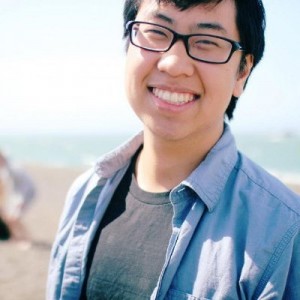
Gregory Chin grew frustrated with the PT Foundation halfway through his eight-week practice experience in Kuala Lumpur, Malaysia. He was working with one of the foundation’s HIV/AIDs clinics, which provides confidential and anonymous STD testing and counseling services that once had been free.
A shift in the organization’s priorities from accessibility to sustainability resulted in a mandatory fee for all clients. To make matters worse, the clinic relocated, further restricting access to clients without reliable transportation.
Like any Global Poverty & Practice student at UC Berkeley, Chin had developed a radar for the kinds of problems he saw at the PT Foundation.
“I thought: You keep forgetting about the people you’re serving,” he said. “You keep running it to make sure this place survives, as opposed to making sure the community you’re working with survives.”
GPP students often recognize and then grow frustrated by the deficiencies of the organizations where they briefly volunteer. The theoretical aspect of the curriculum places heavy emphasis on the critique of poverty interventions. It’s this problematizing that the GPP minor is notorious for, constantly encouraging students to question their organizations and the roles they play within them.
While in Kuala Lumpur, Chin voiced his opinions and lobbied his coworkers for change, but he was aware of his limited authority as a foreign volunteer. He also understood that fixing the problems he encountered required a critical stance.
“We problematize everything we see and then feel frustration as a result. But the fact that we can be frustrated and accept that frustration is a way to motivate ourselves to enact change,” he said. “If we don’t think of why this is better or wrong or what harm it’s doing, we won’t be able to alter it.”
As a Cal student in his final year on the pre-med track, Chin intends to bring this critical mindset to his medical career. “I will incorporate GPP into my future profession by recognizing that there’s always something wrong and there’s always someone who’s not benefitting within a system,” he explained.
For Chin, the often single-pronged, scientific approach doctors take can ignore cultural factors that lead to disease. “It’s about contextualizing experiences, but also about understanding the roots of people’s experiences and using those to understand the systems that people come from.”
Eight weeks in Malaysia gave Chin the time to embrace this more empathetic and individualized approach to medicine—an approach he intends to take one step further. By seeing people as individuals, he hopes to better understand the complex connections they might share. This simple realization has allowed him to go beyond the frustration prompted by the GPP minor and envision a medical career grounded in the complexity of human experience.
“We focus a lot more on how different one person is from another or how different I am from somebody else, but we don’t always focus on trying to find connections,” he said. “When we find those connections, we’re reminded that an individual’s life is complex.”
I-School Course Teaches New Approaches to Measuring Impact
By Tamara Straus
Ever since Hansen Lui was a kid, he loved building things and then taking them apart. During his undergraduate years at UCLA, he said his most valuable experiences took place not in class but in translational research labs, where he got hands-on experience and applied biological knowledge. So when Lui matriculated into the UC Berkeley-UCSF Joint Medical Program (JMP) this summer, he went looking for a similar way to connect his hands and his mind with his medical studies.
At Cal’s School of Information, he found a listing for a course called Hacking Measurement taught by Dav Clark, a fellow at the Berkeley Institute for Data Science, and Javier Rosa, a computer science and development engineering graduate student. Hacking Measurement appealed to Lui because it promised an experiential learning approach to measuring people and the environment through mobile devices, remote sensing, and the Internet of Things—a phenomenon of increasing importance to the healthcare field.
“Typically, we healthcare professionals lack an understanding of what goes on inside a machine,” said Lui. “And if you don’t know how a medical device works, you can’t figure out how to make it better or—in the case of developing countries—more accessible, affordable, or usable.”
Lui, along with fellow Hacking Measurement classmates Joris Ramstein, another JMP student, and Jong-Kai Yang, a master’s student at the Berkeley School of Information, have been getting together nights and weekends during the fall of 2015 to create a prototype for a biosensing device called HeartBEAT. The technology is a portable, low-energy, bluetooth-enabled electrocardiogram that can record the electrical activity of the heart using electrodes placed on a patient’s body.
Although there are now several companies selling portable consumer EKGs, such as Qardio, Lui, Ramstein, and Yang aim to design their device for low-income patients and clinics. “If you look at the price of getting an EKG test at a U.S. hospital, it’s $30 to $100 every time with insurance coverage, and $300-$1,200 without insurance. We hope to make our device available under $100,” said Lui.
Yang noted, however, that the device is in early prototype stages and is not very user-friendly. He said he and his classmates are just as interested in tinkering with the growing number of sensors as they are in taking this one to market.
“It’s a very self-driven class,” said Ramstein. “We’ve been learning not just about how to collect and visualize data, but also about using geospatial satellite images to understand how environmental changes are occurring.”
Clark said he has been surprised that the biggest draw for the course has not necessarily been the seminars, which are conducted by himself, Rosa, and guest speakers such as Fabien Chraim, a Cal grad and CTO of the 3D geospatial intelligence provider Civic Maps, and Dawn Nafus, an anthropologist leading Intel’s Data Sense team. Rather, students are drawn more to the “CoLabs,” where the tutorials and practicums on subjects such as visualization and exploratory data analysis take place with support from the Social Science Matrix, the D-Lab, and Berkeley Research Computing.
All Hacking Measurement students are working with clients, who help determine a project’s road map. One such client is Peter Sand of ManyLabs, an open science network and maker space in San Francisco that is working with students on air quality sensors. Another client is Temina Madon, executive director of UC Berkeley’s Center for Effective Global Action (CEGA), which is working with students on text scraping and integration of economic development data. Yet another student team is working with UC Berkeley research seismologist Robert Nadeau on earthquake measurement and visualization.
Clark compares the measurement possibilities that come from sensors similar to the manufacturing possibilities that have risen due to 3D printers. “Once you understand that building and deploying sensors is something that’s possible and feasible, your idea about how to measure impact changes dramatically,” said Clark. “And with the ability to directly measure things come better results.”
Rosa, who devises technological interventions to alleviate poverty and inequality in low-income regions, is seeing that data measurement and analysis are rapidly changing the social sciences, specifically the field of international development.
Among the big changes Rosa has witnessed is in microgrid design. By deploying smart meters, he and his colleagues in the DIL-supported Rural Electric Power Project in India have been able to use sensors to figure out when people are using electricity, how much electricity they are using, and from there what is the appropriate microgrid size to ensure efficient rural electrification. Recently, Rosa has been working with Niuera to build FlexBoxes, which monitor freezer consumption to enable the integration of renewable energy into emerging regions.
“This is the way to figure whether and an intervention that costs, say, a quarter million dollars actually benefits users, whether it can scale, and in what contexts,” said Rosa. “Direct measurement has just become crucial to evaluating projects for their impact.”
Going “Beyond the Bowl” to Achieve Gender Equity in Sanitation
By Tamara Straus
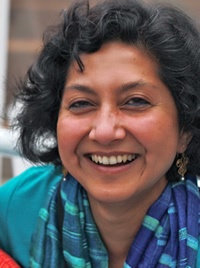
In 2013 Isha Ray, a UC Berkeley professor and international water expert, received a request from UN Women—to determine whether progress on sanitation in the world’s poorest places has been gender equal.
“I realized I couldn’t answer that question,” said Ray, who has spent 16 years studying the intersection of economic development and safe water. “Having potties here and there doesn’t tell me whether they’re serving women’s needs. ”
Although access to sanitation in the world’s poorest places has improved markedly over the past decade and has become one of the 17 Sustainable Development Goals announced by the United Nations in September 2015, the question of women’s needs, particularly menstrual hygiene management, has not been widely addressed in sanitation programs. This is largely because there are still many cultures that consider a menstruating female unclean, untouchable, or bad luck.
Among international development researchers, female-specific sanitation also has not received much attention. A forthcoming scholarly literature review by the UN’s Water Supply & Sanitation Council (WSSCC) has discovered that there has been very little analysis when it comes to the question of whether toilet access, design, or programs satisfy female needs around menstruation, menopause, and infant or elder care. And although there is a big push (and need) to implement off-grid toilets at the home level, there are few sanitation programs specifically designed to make sure low-income girls and women in developing countries have the access, privacy, and conditions they need to go about their public lives when they are menstruating, pregnant, or recovering from pregnancy.
“The WASH [water, sanitation, and hygiene] community is obsessed with stopping outdoor defecation and installing latrines at the household level,” said Archana Patkar, program manager of WSSCC, during a recent lecture at UC Berkeley’s Blum Center for Developing Economies. “This is important and necessary, but girls and women are not always at home—they are in school, they are working. And when they don’t have access to adequate sanitation and they are menstruating, 36 percent of girls and 96 percent of women don’t go to school or work.”
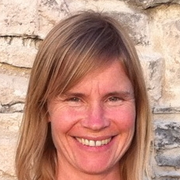
Facts like these have compelled Professor Ray, along with research partners Kara Nelson, a professor in UC Berkeley’s Department of Environmental and Civil Engineering, and Michael Lindenmayer, CEO of the nonprofit Toilet Hackers and a UC Berkeley visiting scholar, to commence an action-research project they are calling “Trisan: Going Beyond the Bowl to Achieve Gender Equity in Sanitation.”
The project, which has received seed money from the Blum Center’s Development Impact Lab, will research women’s needs for safety and privacy—not only for defecation, but also for urination and menstrual hygiene management. It aims to develop programs and practical education and outreach material in collaboration with WASH-related NGOs, girls’ schools in India, and the WCSCC.
Ray said during her past two years of research, she has found that most sanitation programs are still being designed implicitly for the male body’s needs. “Although the defection needs are the same, the urination needs are not the same,” she said. “Females cannot pee standing. They cannot use public urinals or go behind a tree. It’s not modest. So the ratio of toilet facilities to bodies in schools, slums, and streets needs to be examined.”
One of the arguments that Ray, Nelson, and Lindenmayer have begun to make is that sanitation programs should be geared explicitly toward female bodies and female needs. The reason, said Ray, “is if sanitation programs are designed for female needs, they will also serve male needs and disabled needs.” Men may not need to use a private latrine four times a day outside of their homes, but menstruating women do. This difference, argued Ray, should have a significant effect on current thinking around multi-family sanitation units in the world’s increasingly populous slums, settlements, and refugee camps.
So far, the Beyond the Bowl research team has not come up against much criticism with these initial research concerns, but it has gotten some important feedback. Among public health experts, said Ray, the questions they encounter are: What is your hypothesis? What are you going to test? Ray said those questions will be answered through their collaborative research. As for city planners, they point out that designing sanitation services for low-income women is more expensive. “Actually, I agree with that,” said Ray “But if it is, then it is, and we have to think about creative financing.”
Ray said she also agrees with those in environmental engineering who say that dealing with waste removal is imperative, and that flushable toilets in low-income public spaces in many developing countries are a long way off. “We must focus on these engineering questions, absolutely,” said Ray, “but we have to add menstrual waste to our waste disposal problems. We can’t just have fecal waste to worry about. Where are those pads going to go?”
Ray is quick to answer her own question: “Those pads are going into the toilet or into the pit latrine. Is it any wonder they fill up? Or they go in a girl’s bag, next to her books and her lunch. Or they are furtively tossed away. Or they have nowhere to go, so females stay home and miss school and work. All of these are bad solutions relative to creative financing.”
In the end, Ray and her colleagues believe the international community needs to start designing and promoting sanitation to achieve gender equality, in addition to public health. “One of the core principles of the 1948 Universal Declaration of Human Rights adopted by the United Nations was the principle of nondiscrimination,” said Ray. “Human rights cannot discriminate by religion, gender, age, language, or sexual orientation. Yet I feel sanitation programs, with the best intentions in the world, in fact violate that core principle—because they’re geared toward defecation and not urination and menstrual hygiene management.”
The short-term timeline for Ray and her colleagues’ research is to build out their network of sanitation experts and sanitation-focused NGOs and to finish a position paper on achieving gender equality through sanitation, which they will present at the March 2016 meeting of the UN Commission of the Status of Women in New York.
“Of course, we’re not going to argue that we can achieve gender equality exclusively through sanitation; that’s crazy,” said Ray. “But we will ask the Commission to consider sanitation as a pathway towards gender equality—exactly as we would consider employment opportunities or educational opportunities pathways.”
Help Support the Blum Center During the Cal Big Give on November 19
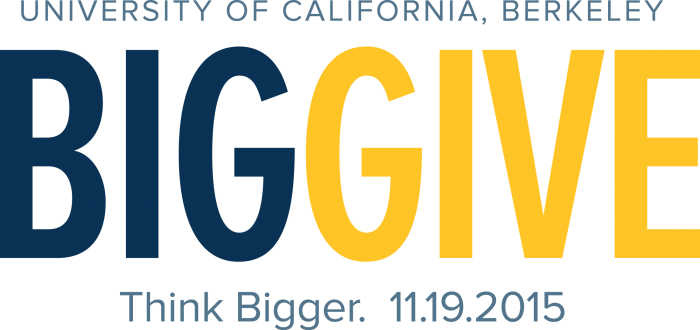
Blum Center for Developing Economies will be participating in this year’s Cal Big Give, an annual one-day fundraising event to support students, faculty, and campus programs at UC Berkeley.
Some of our proudest accomplishments over the past decade have included:
- The Global Poverty & Practice minor, now the most popular minor on campus, has educated over 14,000 students in our classes, graduated over 600 alumni, and completed Practice Experiences in over 60 countries.
- The Big Ideas@Berkeley contest, in its tenth year, which continues to produce impactful innovations, and equally more important, encourages a diverse student population to think of themselves as innovators. To date, winners of the contest have leveraged at least $55 million in additional funding for their high impact projects.
- The Development Engineering minor for PhD students training them to improve human and economic development in complex, low-resource settings. Just launched last year, it is already being replicated in several global universities and training a diverse student body, including 50% women, with the 21st century skills they will need to make an impact.
To enable these and other great programs to grow and thrive, we hope you will consider supporting the Blum Center during this year’s Cal Big Give:
When: 9pm Wednesday November 18 – 9pm Thursday November 19 (PST)
What: Please visit the Blum Center giving page and select the “Blum Center for Developing Economies General Support” option to enable the our programs to grow and train even more students.
To support GPP or Big Ideas directly,
- Invite your family and friends to visit the GPP giving page and select the “Global Poverty & Practice Student Support” option to enable funding for practice experiences for current and future GPPers! Even a $10 donation will be greatly appreciated.
- Support the Big Ideas contest during the Big Give at the Big Ideas giving page. In honor of the Big Ideas Tenth Anniversary, we encourage you to give in the “Power of 10” (any multiple of $10 you feel comfortable giving).
What else: Please tweet a photo or a short story about your Blum Center experience and the hashtags #BlumGive, #BigIdeasGive, #GPPGive, and #CalBigGive (There are social media contests throughout the day, and we can win extra support from the campus, so Tweet as often as you like during those 24 hours)
Please contact sophi@berkeley.edu at the Blum Center with any questions!
Go Bears!!
Clarifying Poverty Action: A Profile of GPP Student Kristian Kim
By Nicholas Bobadilla
Kristian Kim decided to pursue a minor in Global Poverty & Practice because she felt a moral impetus to mitigate poverty. Instead, she found herself immersed in critical reflection and uncomfortable questions that forced her to examine her own role in the systems driving global inequality.
A double major in Development and Peace & Conflict Studies, Kim completed her practice during the summer of 2015 with AFSCME 3299, a labor union that represents University of California service and patient care workers statewide. She conducted research and interviews with workers, and examined how administrative decisions trickle down to affect their wages, job security, and benefits. Through her work, Kristian developed relationships with on-campus employees and gained a deeper appreciation for the people who make her life as a student possible.
“Getting to know people whose labor and struggle make it possible for me to come to school on a daily basis has tied me more to campus,” said Kim. “Understanding my relationship to them has helped me better understand my responsibility to support them as they struggle.”
That struggle involves a demand to be hired directly by the university, which currently outsources workers from private companies that do not provide the wages or benefits required to ensure economic stability.
Kim’s work on behalf of AFSCME 3299 also resonated with her personally. The socioeconomic struggle facing many campus workers, she said, resembled that of her own family members. Her grandparents fled North Korea in the 1950s and immigrated to the United States from South Korea with her parents in the early 1980s. Kim entered GPP knowing the sacrifice her family made to provide the stability in which she grew up. But witnessing the struggle of UC workers firsthand brought her closer to her own family’s hardships.
The Global Poverty & Practice minor is one of the most original, unorthodox, and progressive poverty studies programs in the country. (Full disclosure: I am a GPP minor.) Since its inception by the Blum Center in 2007, the minor has become one of the largest minors on campus, with students from numerous disciplines. GPP aims to supplement students’ chosen fields, encouraging them to engage with poverty on a systemic level and critically reflect on their own positions in relation to the problems they seek to address. In addition to teaching the prevailing theories on global poverty and development, the GPP program requires a minimum six-week “practice” component, in which students work with an organization dedicated to poverty alleviation or socioeconomic development.
Said Kim: “[GPP] gave me a different way of understanding some of the struggles my family members had as people, not just as stories, but as people who go to work and are exploited and struggle to make ends meet.”
Kim’s practice experience also reaffirmed the privilege she enjoys as a result of her family’s and UC workers’ sacrifices. This sense is not unusual among GPP students, who are taught to reflect on the factors that make their socioeconomic positions possible. It is an approach that ensures students are aware of the benefits they have, and it aims to prevent them from becoming complicit in the problems they try to ameliorate.
“My work with GPP contextualized my work with AFSCME and all my work in general. It’s given me a space to be critical without being paralyzed by cynicism,” said Kim.
Kim is referring to the commonly quoted words of Professor Ananya Roy, one of the founders of the minor who created its introductory course, GPP 115, at UC Berkeley. Roy often spoke of the “impossible space between the paralysis of cynicism and the hubris of benevolence.”
These words capture the essence of an educational program that provides an uncomfortable awareness of the factors responsible for systemic inequality. Students are encouraged to question their motivations and many come to recognize their own complicity in the systems that create global poverty. Kim is no exception, and expresses a deep awareness granted by the minor.
“GPP showed me things are messed up, but we engage with these forces every day. My choice to engage in specific aspects of struggles comes with the responsibility to fight those forces.”
This conviction drives Kim’s continued study of global poverty and her ongoing work with AFSCME.
“I move forward with that knowledge that I have a responsibility to undermine the systems that privilege me at others’ expense,” she said.
Such a realization has been possible due to the reflective tools provided by the minor. GPP 105 teaches students common methods used in fieldwork, while building habits for reflecting on the modes of power and inequality that come with their roles. It is this reflective component that Kim believes is one of the most standout features of GPP, in that it encourages students to go beyond the typical approaches to poverty utilized in academia.
“The way poverty alleviation is often approached at Berkeley is by looking at the global impact an organization can have, but that often comes with a disregard for the experiences of the people in poverty. This approach can undervalue the importance of these experiences,” she explained. “I think doing the work I did over the summer showed me I can’t ignore the way it [poverty] plays out in people’s lives.”
Kim recognizes the role she once played in perpetuating the conventions of poverty, yet the GPP framework has allowed her to step outside her previous mode of thinking and deconstruct those conventions.
“If you find yourself reducing people to things,” Kim said, “you need to face what keeps you from recognizing that your liberation is implicated in other people’s liberation. Thinking about poverty action that way makes it clear what you’re responsibilities are.”
blueEnergy’s Water and Sanitation Technology for Nicaragua
By Carlo David
The enormity of the world’s water and sanitation problems cannot be overstated. UN Water estimates that more than 3 million people die from water, sanitation, and hygiene-related causes each year, and nearly 10 percent of the global disease burden could be reduced through improved water supply, sanitation, hygiene, and water resource management.
In Nicaragua, the problem is no less dire. Among a population of just over 6 million, 48 percent don’t have access to adequate sanitation, according to a World Bank study—and 15 percent don’t have access to safe water, with much higher percentages for both needs in rural areas. This is particularly unfortunate because Nicaragua is known as the land of lakes and volcanoes; its rivers and reservoirs are far from parched like California. But it doesn’t have good water and sanitation infrastructure, which means many Nicaraguans rely on unfiltered water from groundwater sources, which are often contaminated by fecal matter.
That’s where NGOs like blueEnergy come in. Since 2004, the San Francisco-based nonprofit founded by Berkeley graduate Mathias Craig has been developing sustainable and community-based models to provide residents of Nicaragua’s Caribbean Coast access to clean water and improved sanitation. Among its projects are biosand water filters, which use gravity and naturally occurring bacteria to largely eliminate water contaminants and provide safe drinking water. Since 2009, blueEnergy has installed 900 biosand filters, which have benefitted more than 4,500 residents.
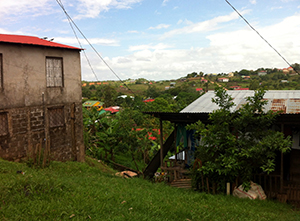
While there are septic tanks and stand-alone latrines in the Nicaraguan towns where the nonproft works, such as Bluefields, these facilities are rare and expensive. blueEnergy navigates the lack of municipal-level water treatment facilities by working at the household level. With a team of research fellows, interns, and community members, the nonprofit is helping transform how residents access clean water.
“The biggest impact that blueEnergy has is we pull together all the dimensions of a solution—people, technology, financing, planning, management—in a setting where the challenges are complex and the service ecosystem is not very well developed,” said Craig, who graduated from Cal in 2001 with a BS in Environmental Engineering.
During the summer of 2015, Badisha Roy, a Berkeley undergraduate student in the Department of Chemical Engineering, interned with blueEnergy to conduct comprehensive testing on biosand filters distributed to Bluefields residents in 2010. Funded by Cal Energy Corps and the Berkeley Energy and Climate Institute (BECI), Roy is among an annual group of students chosen to participate in blueEnergy’s programs in Nicaragua.
Roy said implementing a project of this nature poses numerous structural challenges. Bluefields may be Nicaragua’s chief Caribbean port, but there is rampant poverty, high unemployment, and lack of economic growth. “Water and sanitation are so important and fundamental to people’s daily lives, but not everyone in Bluefields has access,” said Roy, who added that coming up with solutions requires “identifying people’s needs and how you are going to provide those needs.”
While blueEnergy maintains a small number of researchers and interns, it relies significantly on its local staff, community members, and senior fellows, who administer day-to-day operations and constantly train and educate beneficiaries about proper usage of filters and how to inspect latrines.
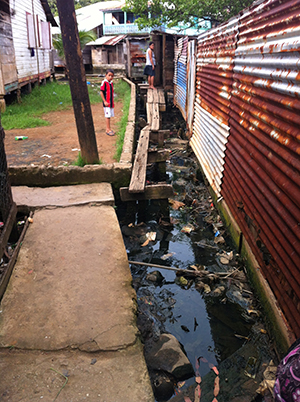
During her two month fellowship, Roy and her team examined hundreds of filters. After surveying 330 filters in 16 different neighborhoods, installed five years ago, they reported some positive outcomes.
“Generally speaking, most filters were functioning well. They met five or six of the eight parameters we have established to test the efficiency of these filters,” said Roy.
In extreme cases, while water sources and containers tested negative for E. Coli bacteria, the filtered water tested positive. These results demonstrated potential areas to be addressed to avoid reactivation of contaminants as well as the need for more conducting more community training on proper usage of the filters.
Although Bluefields has a long way to go in terms of economic development, filters introduced by blueEnergy have had some impact. Stay-at-home mothers reported being able to start small cafeterias and eateries in their own homes, without the fear of endangering their families and customers’ health by serving unfiltered water.
“Our goal for the future is to see the Caribbean Coast go from 80 percent being without clean water, sanitation, and electricity to 80 percent with clean water, sanitation, and electricity through direct service government partnerships and incubating new service-providers,” said Craig.
The Fast Trains of Mumbai: A GPP Grad Reflects on Living and Working in India’s Most Populous City
By Priyanka Athavale
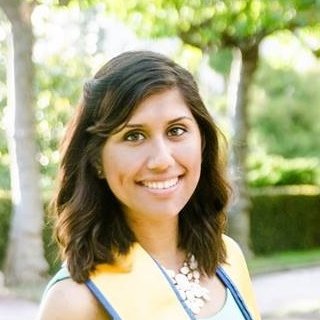
Today was the epitome of the Mumbai fast train experience. It was utter frustration, suffocating stench, and packed with bodies. At the same time, the train felt systematic, organized, even solitary. This duality—a kind of chaos within order—is what defines Mumbai, the most populous city in India and the country’s financial, commercial, and entertainment capital.
For someone from suburban California, accustomed to organized roads and paved sidewalks, taking the trains is something of an adjustment. Yet I saw the transport as a feat—and not just any feat, a feat that thousands of Mumbaikars accomplished every working day. After four months in the city, my aim was to be a true Mumbaikar. Riding the fast trains would be the ultimate validation of my belonging.
I stood at the platform ready to board, my face sweaty, my palms clammy. The sun beamed in my eyes, as I read the digital sign blaring in red digits “F02,” indicating the fast train was approaching in two minutes. Mumbai’s trains are a miracle of mass society. Spread over a 465-kilometer network, they carry about 7 million passengers a day. Around 3,000 people die every year on the trains, most from falling or being pushed off the packed cars.
Standing there, I could hear my Indian family members warning me against the fast trains. I buried their sounds. I looked to my left, to my right, and felt a lump forming in my throat—the feeling you get when you’re about to drop 50 feet in a roller coaster. Seventy women stood at the platform, on par with me, ready to board the train.
Whatever confidence I had started to evaporate. I realized there was no way 70 people were going to board the train. It simply wasn’t possible. But there was no time to make an alternate plan. I needed to get to work. I had to board the train, and it was already in sight.
The train approached and then screeched to a halt. Women started pouring out of the ladies car. Pouring is an understatement. Women were flooding out. They were getting thrown out with their babies, their bags, their young children, all rushing to escape the havoc. There were women in saris, women in business clothes, women selling fish, women hocking earrings, fat women, thin women, old women, young women—they were like marbles gushing out of a bottleneck. At the same time, the 70 women on the platform were trying to get in.
Inside my head, I thought, “THIS IS RIDICULOUS!” but maintained a calm exterior. There were collisions, verbal conflicts, insults. Women were shoving other women, defending their bags, moving haphazardly—and all the while, I was getting sucked into the crowd with my two bulky bags. I closed my eyes and let the crowd take me in.
I appeared composed yet inside I was fuming: This experience should not be the norm for millions of women. The trains have to change—they needed a total revamp! The only thing calming me down was John Mayer blasting through my headphones, “Waitin’ on the world to change.”
Fury and fuming are familiar emotions in Mumbai. During my initial days, I questioned the streets crowded with rickshaws, the cows roaming aimlessly, the myriad of fruit and vegetable carts, the stray dogs and cats, and the street dwellers scattered on the sidelines. Everyday, I saw street children, some crying, some sleeping, some basking in the sun, and their mothers trying to manage a thousand things at once.
As Fulbright-Nehru scholar, my purpose in Mumbai was to conduct qualitative research on maternal barriers to child nutrition among families making less than $5 a day. I considered myself part public health researcher, part anthropologist, and part humanitarian. But when I walked through the streets of Dhobi Ghat, a large Mumbai slum, all I felt was appalled. My eyes stuck on corner stores selling junk food, the mildew-stricken jugs containing “fresh” water, and the half-clothed children wandering barefoot between homes.
Yet the mothers I encountered expressed hope about the future, despite the conditions they face. They are among the most inspiring and energetic women I will ever met—household managers, caregivers, and wives facing multiple daily lacks—of toilets, adequate food, clean water, effective education, and access to basic, affordable healthcare.
Mumbai is rife with juxtapositions: of affluence and poverty, of technological advancements on the one side and lack of electricity on the other, of towering highrises shadowing low tin-ceiling slums. How can a place like this be? The answer lies in the intrinsic necessity to survive. The city has an intangible energy; it is a place where resilience blossoms from struggle.
Back in the train, I let myself be taken through the crowd. Gradually, I realize I am part of team, a group of women, albeit complete strangers, who share a common cause and are helping each other toward it. The women guide me through the battleground of the train car and allow me to pass through. I find a little oasis near the window where I can stand.
I take a deep breath of air—the feeling of relief is unmatched to any I’d felt before. I look around and notice every woman is engaged in some activity: talking, sleeping, people watching, holding onto children, selling trinkets. I am just another woman in the crowd, trying to get to my ultimate destination. This train is a microcosm of the city. It could use some oiling, but it works and it has been working for years.
Priyanka Athavale graduated from UC Berkeley in 2014 with a double major in Molecular and Cell Biology and Public Health and a minor in Global Poverty & Practice. She was awarded a Fulbright-Nehru Fellowship to study barriers to improved nutrition and health practices in the urban slums of Mumbai, India.
Turning Feces to Fuel in Kenya
Undergraduate Research on the Rise at Cal
By Tamara Straus
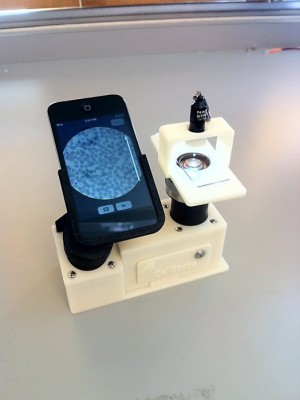 Over the past year, UC Berkeley PhD student Zack Phillips and a team of six undergraduates assembled an LED array dome to fit on the Fletcher Lab’s CellScope microscope. The LED array did exactly what the team hoped for: it allowed the smartphone-enabled device to function as three separate microscopes.
Over the past year, UC Berkeley PhD student Zack Phillips and a team of six undergraduates assembled an LED array dome to fit on the Fletcher Lab’s CellScope microscope. The LED array did exactly what the team hoped for: it allowed the smartphone-enabled device to function as three separate microscopes.
Phillips, who works with Assistant Professor Laura Waller in the Computational Imaging Lab, notes that the adapted device is still too fragile to be field tested for tropical diseases. But he is willing to admit that his team’s youthful composition and the speed of their invention are impressive. Phillip’s research group consists mostly of 19- and 20-year-olds and they completed their project in about 800 hours. The team’s next step is to take their $1,000 version—combining the imaging power of three $10,000 microscopes—and turn it into something sturdier that eventually can be priced for clinicians in developing countries at around $500 (not including the cost of the smartphone).
Professor Waller is certainly proud of this young team’s latest innovation. Yet she underscores that her research group and many others in the Department of Electrical Engineering and Computer Sciences have plenty of accessible projects for undergraduate students and that plenty of undergraduate students are making valuable research contributions.
In the case of the Cellscope project, supported by the Blum Center’s Development Impact Lab, it has offered undergraduates the chance to tinker with Arduinos—an open-source prototyping platform based on easy-to-use hardware and software—that are often taught in high school. Other reasons for increased undergraduate involvement and research contributions, says Waller, include: the “maker movement,” which has popularized lab invention, and the affordability of 3D printers, which allow research groups to iterate new versions in a matter of hours.
“It’s totally different now that when I was an undergraduate,” says Waller. “There were 3D printers then, but now we have access to them.”
Waller points out that college student research contributions are also due to a general attitude about the reciprocal nature of undergraduates in university research. Both sides have something to gain—professors gain engaged college students and students gain a useful learning experience.
“Research is a really nice way for undergraduates to understand the real-world application of their skills and operate in an environment that’s a little bit more like a real job,” says Waller. “It’s a fantastic supplement to their formal education that will serve them better in their future careers.”
This is true not only for the College of Engineering but also for departments across campus. According to Stefanie Ebeling, who runs Cal’s Undergraduate Research Apprentice Program (URAP), founded in 1991, there is “definitely an upward trend” in undergraduate participation in faculty research. Ebeling said that there were 550 participating students in the fall of 2005; 935 in 2010; and this fall, there are 1,250 undergraduate research apprenticeships.
URAP was founded several years before the Boyer Report, which was published in 1998 by a commission of educators sponsored by the Carnegie Foundation and chaired by its president Ernest L. Boyer. Entitled Reinventing Undergraduate Education: A Blueprint for America’s Research Universities, the report argued that undergraduates at large research universities were often inadequately taught, due in large part to high student/faculty ratios, a predominance of lecture-based courses, and the demands on faculty besides teaching. The Commission argued that research universities should not try to emulate the teaching practices of small liberal arts colleges, but should take advantage of their research-related resources, integrating undergraduate education into the pursuits of graduate students, postdoctoral researchers, and faculty.
In the Commission’s words: “…Undergraduates can become junior members of the research teams that now engage professors and graduate students.”
In a November 2013 Center for Studies in Higher Education paper following up on the progress of the Boyer Report recommendations, authors John Aubrey Douglass from UC Berkeley and Chun-Mei Zhao from Stanford summarized the findings of 2010 Student Experience in the Research University (SERU) undergraduate survey, which was administered at all nine UC campuses and six top-25 public national universities.
Among the 130,000 students who answered the survey questions, most (81.3 percent) conducted research as part of a class assignment, such as a research paper—with 40.3 percent assisting faculty in research with or without pay and course credit. Douglass and Zhao found that assisting research faculty is more prevalent in the STEM fields, while independent and personal research is more likely in the humanities, social sciences, and professional majors.
The two authors also found that undergraduate research engagement “leads to self-reported learning gains across many areas, but especially in the areas of field knowledge, how to present and communicate knowledge, research skills, higher levels of satisfaction, better use of time, and higher levels of non-quantitative skills.”
“I think there are some clear reasons why everyone on campus—from students, to faculty, to administrators, to parents—has growing excitement for undergraduate research,” says Sean Burns, director of the UC Berkeley Office of Undergraduate Research & Scholarships. “On one hand, research opportunities give undergraduates a chance to freely pursue their interests and passions. In this sense, research can epitomize the beauty of liberal education. On the other hand, engaging in research—both in terms of skill building and in terms of knowledge produced—turns out to be one of the most pragmatically beneficial choices an undergraduate can make. What employer or graduate school isn’t thrilled to hear a student speak of their research accomplishments?”
On October 1, 2015, Burns organized an Undergraduate Research Fair that brought together about 400 students and faculty, including Randy Schekman, who won a 2014 Nobel Prize in Physiology or Medicine and regularly employs undergraduates in his cell biology research lab. Burns said the event attracted a large number of first and second year students from the STEM fields, but there were a decent of students from social science and other disciplines as well.
Brandie Nonnecke, a research and development manager at the Center for Information Technology Research in the Interest of Society (CITRIS), agrees that STEM students, and particularly computer science students, are in demand at her and other university labs. But she also notes that many of today’s undergraduates are by nature problem solvers and tinkerers.
“They’re being called the Benjamin Franklin Generation,” says Nonnecke. “They’re not afraid of a challenge, and I think they gain a lot of joy in getting hands-on experience.”
Nonnecke says that on CITRIS’ CAFÉ project, an open source, e-participation platform on social and political issues, undergraduates have been instrumental in building the platform. Currently, the CAFÉ team employs six undergraduate students and two Industrial Engineering and Operations Research graduate students.
Aditya Gande, a third year Electrical Engineering and Computer Sciences student who worked on the CellScope in Professor Waller’s lab in 2014 and 2015, explains he sought out a research opportunity because he considers it the best way to get experience outside classwork during the school year.
“A lot of people do their own projects,” says Gande, “but I thought I’d go for lab work, because it’s a little more structured and prestigious. Also, from a job perspective, it’s really difficult to add onto your resume if you’re not doing research.”
Gande, a Regents Scholar, has been thinking along these pragmatic lines since he was a teenager. While a junior in high school, the Cupertino resident landed a lab position at Stanford, making a basic android app for Assistant Bioengineering Professor Manu Prakash Lab’s Oscan device, a cell phone-enabled scanning tool for the mouth. Gande then went on to create open source software for 3D image modeling on 2D images. And in his senior year, he analyzed images of beetles to get their flight data.
Although Gande doesn’t plan to get a PhD, he does intend to continue his research career at a medical device startup.
“I don’t want to indulge myself and waste my youth working on social media apps or something like that,” he explains. “I feel medical devices are more impactful, even though they take longer and require much more effort. Low-cost health is important everywhere.”
As for whether it’s difficult to find research opportunities on campus, even for students without computer science skills, Gande has this to say: “Berkeley is a research university. Anyone who says they can’t find opportunities doesn’t know what they’re talking about.”
Five Questions for Robert Reich about Saving Capitalism: For the Many, Not the Few
By Tamara Straus
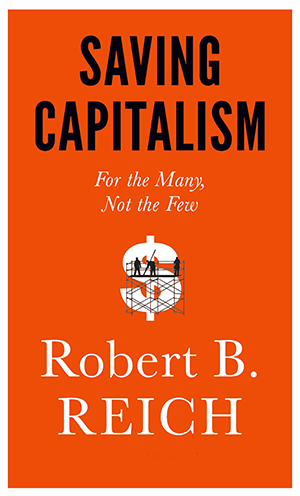 Robert B. Reich is among America’s first multi-platform public intellectuals. The Blum Center’s Senior Fellow and Chancellor’s Professor of Public Policy has written 12 books, is a constant producer of videos and movies, and has a massive Facebook audience, thanks to his rapid-fire production of commentaries and blogs. At 69, after decades of public service as a public university professor and government administrator (most notably as President Clinton’s Secretary of Labor), his work life has become even more ambitious—to unveil and correct what he sees as the imperiled state of American democracy.
Robert B. Reich is among America’s first multi-platform public intellectuals. The Blum Center’s Senior Fellow and Chancellor’s Professor of Public Policy has written 12 books, is a constant producer of videos and movies, and has a massive Facebook audience, thanks to his rapid-fire production of commentaries and blogs. At 69, after decades of public service as a public university professor and government administrator (most notably as President Clinton’s Secretary of Labor), his work life has become even more ambitious—to unveil and correct what he sees as the imperiled state of American democracy.
The Blum Center sat down with Professor Reich to talk about his latest book, Saving Capitalism: For the Many, Not the Few. In it, he passionately argues that the U.S.’s current political polarization stems from the wrong argument. Americans should not be choosing between “big government” and “small government” or the degree to which we should promote a “free market”—they should be debating the benefits of a market organized for more inclusive prosperity or one designed to deliver the most gains to the top. Written at a time when the United States faces the greatest income inequality and wealth disparity in 80 years, “Saving Capitalism” aims to lay out what’s at stake for the present and the years ahead.
You write that you are confident we can save capitalism from its own excesses and return to a period of fairer distribution of wealth. But how do you remain confident when, for example, Thomas Piketty argues in his best-selling Capital in the Twenty-First Century that an ever-rising concentration of wealth is not self-correcting (and does it through data going back 250 years)?
Piketty focuses only on wealth concentration, not income concentration. Yet the central feature of inequality in America is income concentration. And the good news is America has repeatedly reformed itself with regard to excessive concentration of income and its attendant political consequences. We did so in the Jacksonian era (the 1830s), the Progressive era (1901 to 1916), the New Deal (1933 to 1939), and, to some extent, in the Great Society (1964 Civil Rights Act, 1965 Voting Rights Act, 1965 Medicare and Medicaid). In other words, we have a strong track record of expanding the circle of prosperity when capitalism gets off track.
Which group of Americans would you most like to reach with this book?
I want to reach average Americans who are confused and frustrated about the current political-economic system, who don’t want to scapegoat immigrants or the poor for their problems, and who are open to uniting with others in order to mobilize and organize a movement to regain control over our democracy and make our economy work for the many rather than the few.
You write that widening inequality has become “baked into” the building blocks of the free market itself. Why don’t more people understand that?
Because the rules that define the basic building blocks are hidden from view, and most people don’t see them or understand them. Most people don’t understand that the rules that define intellectual capital—what can be patented and for how long—have been tilted in the direction of the owners of intellectual capital and against consumers, for example; or how the rules and laws governing contracts have changed (allowing much more leeway for insider trading than ever before, for example); or how the bankruptcy code has been rewritten to favor large corporations over homeowners and student debtors; and so on.
What do you think is the most controversial argument in Saving Capitalism?
Nothing should be controversial in a partisan sense. On this book tour, I’ve talked with many people who call themselves “conservative Republicans” who agree with almost every point I make. They want to end crony-capitalism; they think the biggest Wall Street banks are way too big; they’re opposed to “corporate welfare”; they want to get big money out of politics. Recently a self-described “conservative economist” who had been asked to debate me on a radio show confessed on the air that he agreed with almost all of the book, and praised it. Even my political point—that we need to reestablish what John Kenneth Galbraith once described as “countervailing power”—is not really controversial. I don’t condemn big corporations, big banks, CEOs, or wealthy individuals. My concern is that political power has become too concentrated in the hands of too few, and we need to reestablish countervailing power—perhaps not the same sources of countervailing power as we had in the 1950s and 1960s, but new sources that act as a check and balance upon concentrated power.
What is the best case and worst case scenario for our future political economy?
The best case is we enter another phase of reformist populism, as we have done at least four times before in American history. The worst case is we succumb to authoritarian populism—the quest for a “strongman” who will get the job done, even at the cost of our democratic institutions. So far, America hasn’t succumbed to authoritarian capitalism, although other nations have. But the current path we’re on is not sustainable. One or another—reformist populism or authoritarian populism—will manifest itself over the next two decades.
For more information or to order a book: http://robertreich.org/savingcapitalism
Teachers as Agents of Conflict Resolution in Chile: Big Ideas Winners Kuy Kuitin
Founders of Endaga to Join Facebook
Hygiene Heroes: UC Berkeley Team Promotes Hand-Washing Curriculum to Combat Preventable Diseases
By Carlo David
A group of students, led by Professor David Levine of UC Berkeley’s Haas School of Business, are seeking to combat preventable diseases in developing countries like Bolivia, Cambodia, Tanzania and India, where significant populations do not have access to clean water and soap. Their goal is to make hand washing routine for thousands of students and teachers by introducing a fun and interactive curriculum—called “Hygiene Heroes”—at public schools. The Hygiene Heroes curriculum includes recreational activities, board games, and a book, as well as cost-efficient supplies like “soapy bottles.”
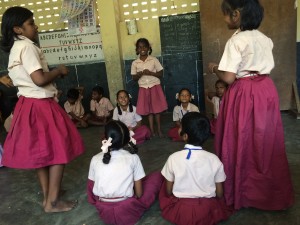
According to the Centers for Disease Control and Prevention (CDC), 1.8 million children under the age of 5 die annually from diarrheal diseases or pneumonia, the top two causes of deaths among young people. The alarming rate of children dying from such preventable diseases prompted Prof. Levine, along with several students, such as Nimerta Sandhu (Haas ’14) and Melanie Cernak (Haas ’15), to undertake this project.
Hygiene Heroes was piloted in Cambodia and Tanzania in the summer of 2013. During the academic year, the team conducted extensive outreach to school districts, principals, and community organizations to test the project’s curriculum. Meanwhile, over the summers of 2013 and 2014 under the leadership of Gautam Srikanth, a Cal undergraduate student in Environmental Economics, several UC Berkeley students traveled abroad to lay the groundwork for expanding the project in Chennai, India.
Prof. Levine explained there are many economic and cultural misconceptions about why people do not develop a hand washing habit. According to a recent World Health Organization and UNICEF report covering 54 middle- and low-income countries, 35 percent of health facilities do not have water and soap for hand washing.
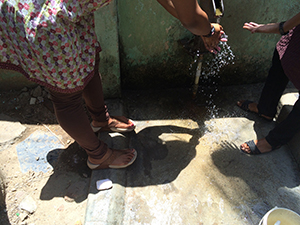
“Lots of people rinse hands with water. The Hygiene Heroes project is targeting people who do not wash their hands with soap,” said Levine. “Even here in the United States, when no one is looking, people tend to not wash their hands with soap.”
Continued Levine: “We introduced soapy bottles, which are basically empty water bottles filled with water and soap. With them, classrooms can create routines, such as squeezing soapy water on each student’s hands as they leave for lunch and head to a faucet to rinse. Such routines constantly reinforce students’ hand washing.”
Hygiene Heroes is working on a shoestring budget with funding from online donors, the Center for Effective Global Action (CEGA), and the Haas School of Business, and is facing equally limited financial resources from the schools that the project is targeting. To deal with these challenges, the team is capitalizing on previous efforts launched in India to promote hand washing.
“We are building on previous curricular efforts,” said Levine. “Part of the task is to reinvent some of the approaches used to promote hand washing with soap.” In the past, said Levine, glitter has been used in games to demonstrate the necessity for children to wash their hands after they play and especially before eating. But glitter is expensive, so scaling such an approach is difficult. Instead, the Hygiene Heroes team is using cost-efficient alternatives, such as chalk dust or even turmeric, to play the “pass the germ (and be aware)” game.
From his time as a senior economist on President Bill Clinton’s Council of Economic Advisors to his present position as the Eugene E. and Catherine M. Trefethen Chair in Business Administration at UC Berkeley, Levine has analyzed the impacts of investing in health and education, especially in poor nations. He is currently one of 19 Cal faculty members behind a new program called Development Engineering for graduate students pursuing research in poverty alleviation.
In the case of this project, said Levine, “One of the challenges is to work with regular teachers, who are busy, and make our proposed curriculum part of their routine. The board game [we introduced in Cambodia] is popular among kids, but because it is not part of their curriculum, it can serve only as supplementary material.”
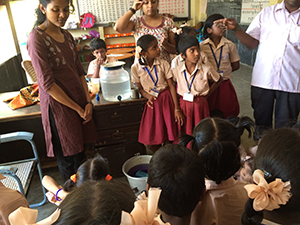
The Hygiene Heroes team has been working across disciplines to find collaborators. Jacqueline Zhou, from UC Berkeley’s Art Department, for example, is the illustrator of the children’s book King Akbar Writes a Law. In the story, Prime Minister Birbal, a popular folk tale character in much of South Asia, requires the palace’s servants to wash their hands with water and soap. The prime minister must convince the king of the importance of the new law, slowly helping the monarch realize that contamination can spread, even if it cannot be seen.
Culture is an important facet of Hygiene Heroes. Nimerta Sandhu, who first joined the initiative in January 2013 and now works as a management consultant in the health industries, found her passion for public health and community service to be a guiding force for her involvement with the project. “Working with underserved and minority communities, the project has been very important to me. I hope to continue these efforts both internationally and within the United States,” she said.
For Melanie Cernak, who now works as a business development associate at a Silicon Valley firm, her first-hand interaction with the children and their enthusiastic reception of her was fascinating, although sometimes uncomfortable. “Students were attentive and largely would listen to me,” she said. “They wanted to wash their hands because they saw Americans washing their hands. But that is not a sustainable model.”
Over the past two years, the project has established important connections inside and outside of Chennai. The Indian Institute of Technology in Madras (IIT-Madras) played a pivotal role in testing Hygiene Heroes in the region, and in searching for schools that benefit from the project. Currently, the team—with more than a dozen students involved—has partnered with Sarva Shiksha Abhiyan (SSA), a government program that is responsible for 30,000 schools under India’s Department of School Education and Literacy. Hygiene Heroes is also hoping to increase its outreach through Teach for India, an Indian adaptation of Teach for America, and CLEAN India, a national campaign advocating for clean, healthy, and sustainable lifestyle.
Although the Hygiene Heroes team is aiming to create long-lasting behavioral change, it does not expect to produce far-reaching results instantly. A project of this scale requires constant engagement and understanding of behavioral and political factors. “It will take a long time,” Prof. Levine said. “But it is the most important solvable problem on the planet.”
GPP Interim Director Clare Talwalker Reflects on Katherine Boo’s Visit to Berkeley
Big Ideas Winners Aim to Digitally Track Vaccinations in Rural India
Blum Center Fosters a New Kind of Development Professional: The Development Engineer (DevEx News)
https://www.devex.com/news/a-new-kind-of-development-professional-the-development-engineer-86919
We Care Solar is awarded US$1 million United Nations Energy Grant to expand the use of life-saving “Solar Suitcase” (United Nations News)
https://poweringthefuture.un.org/news/awardceremony2015
Blum Center-Supported We Care Solar Wins $1 Million UN Award
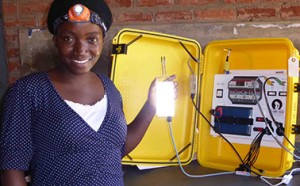
We Care Solar, the Blum Center-supported nonprofit, has won the United Nations’ first “Powering the Future We Want: Recognizing Innovative Practices in Energy for Sustainable Development” award. We Care Solar is being recognized with this $1 million grant for its pioneering work providing sustainable energy to improve maternal and child health. The nonprofit produces Solar Suitcases, which provide light and energy to under-resourced medical facilities, primarily in Africa and Asia.
The award is the first by the United Nations Department of Economic and Social Affairs and signals the convergence of efforts around global health, renewable energy, and sustainable development. It comes on the eve of the UN’s historic adoption of the Sustainable Development Goals.
Laura E. Stachel, We Care Solar co-founder and executive director, accepted the award at a September 14, 2015 ceremony at the United Nations introduced by Secretary General Ban Ki-moon. From over 200 applicants, We Care Solar was one of 12 finalists invited to the United Nations to share sustainable energy practices.
Stachel, an obstetrician, conceived her innovation in 2008 while conducting public health research in Nigeria. She was one of the first experts to recognize the link between maternal mortality and lack of access to reliable electricity. To address this need, she and her husband, Hal Aronson, co-founded We Care Solar in 2010. Together, they developed compact portable Solar Suitcases to provide essential lighting and electricity to maternal health centers. To date, 1,300 We Care Solar Suitcases have been distributed to health centers—and that number is expected to double in the next twelve months.
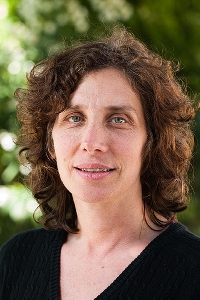
Stachel said: “The United Nations is shining a light on an area that has all too often been overlooked—the lack of reliable electricity in health facilities. I have had the privilege of working with hundreds of health workers who have seen the miracle of light and power in saving lives, and we have much more work to do. This award is the beginning of a brighter future for women everywhere.”
Stachel used her acceptance speech to declare a commitment to light up and power every primary health clinic in the world with renewable forms of energy. Today, as many as 300,000 health centers worldwide lack reliable power. “There can no longer be silos between global health goals and sustainable energy goals. The time has come to collectively work together to give every health care worker the power they need to save lives,” Stachel said.
The Problem with “Help” in Global Development (Commentary by DevEng student Julia Kramer in the Stanford Social Innovation Review)
http://ssir.org/articles/entry/the_problem_with_help_in_global_development
Berkeley Lab Water Technology Boomerangs from Bangladesh to California
By Tamara Straus

In 2006, when UC Berkeley Civil Engineering Professor Ashok Gadgil began researching the possibility of removing arsenic from drinking water using electrochemistry, he targeted his invention at South Asia, specifically Bangladesh and West Bengal, where more than 60 million people are estimated to be consuming groundwater with dangerously high arsenic levels.
Gadgil’s invention, ECAR (short for Electrochemical Arsenic Remediation) has since been tested in his lab and is currently being implemented in the field, thanks to funding from the Lawrence Berkeley National Lab and the Development Impact Lab. Since December 2013, the technology has been under license by the Indian company Luminous Water Technologies, which plans to bring ECAR to arsenic-affected villages throughout India and Bangladesh. Meanwhile, members of the ECAR team, lead by Gadgil and Susan Amrose are conducting a 10,000 liter-per-day trial of the system in preparation for the considerable scaling.
For Gadgil and Amrose, these outcomes are the result of years of experimenting, planning, and partnering. One outcome they didn’t necessarily expect, however, is unfolding here in the United States. During the summer of 2013, Amrose and John Pujol launched their own company, SimpleWater, using the same electrochemical arsenic remediation technology developed in Gadgil’s lab but directed at the tens of thousands of wells and rural American water systems with high levels of arsenic. With funding from the U.S. Environmental Protection Agency, SimpleWater successfully validated the technology in California in 2014 and is now preparing a larger scale pilot in Grimes, California. ECAR was also awarded a 2013 UC Proof of Concept Program Commercialization Gap Grant, to see if it could be used to remediate arsenic-contaminated groundwater in California.
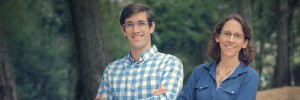
This turn of events is a prime example of what business and engineering scholars are calling “reverse” or “boomerang” innovations—whereby products and services developed as inexpensive models to meet the needs of developing nations are then repackaged or remodeled as low-cost alternatives for developed markets. In the case of Grimes, a town of about 550 people 50 miles north of Sacramento, ECAR technology may prove as useful to residents as those in rural Bangladesh—although the regulatory, political, and environmental conditions are quite different.
Amrose explains that the water treatment needs of remote, low-income, and small American communities have largely been ignored, because U.S. innovation focuses so much on large municipal systems. “ECAR technology was designed to be affordable and robust in rural and primarily very low-income South Asian communities,” she said, “which translates easily to the unmet U.S. needs that SimpleWater is addressing.”
One reason that arsenic-contaminated water has been overlooked globally is that it is hard to detect. Arsenic dissolves from soil and rock into drinking water supplies and is tasteless and odorless, but it unquestionably a poison. Over the past few decades, scientists have found increasing evidence that chronic ingestion of arsenic results in lower IQ in children as well as severe maladies, such as lesions, diabetes, cancer, and blood vessel diseases that can lead to gangrene, amputation, and premature death. As a result, in 2001-2002 the World Health Organization and the Environmental Protection Agency set a new drinking water standard prohibiting the consumption of water with more than 10 parts per billion (ppb) of arsenic. Yet arsenic in drinking water has remained an international problem for which long-term solutions have been elusive.
As Gadgil told Lawrence Berkeley Lab News in a 2014 article, “A lot of technologies to remove arsenic on the community- and household- scale have been donated. But if you go to these villages it’s like a technology graveyard. One study found that more than 90 percent failed within six months, and then were abandoned to rust in the field.”
Among the reasons Gadgil thinks ECAR could prove effective is that the technology has been created to be inexpensive and easy to maintain. Unlike complex chemical processes or maintenance-heavy devices, ECAR works by using electricity to quickly dissolve iron in water. This forms a type of rust that binds to arsenic—and that can then be separated from the water through filtration or settling. ECAR is not meant to serve large populations that are serviced by government water systems. Instead, the technology is designed for residents who can collectively maintain and own a water system.
One of the goals of SimpleWater’s ArsenicVolt system is to provide remote monitoring of arsenic levels. This is being done, said CEO Pujol, for a very simple reason: There are few water engineers in the U.S. with expertise in arsenic or other heavy metals—and even fewer who will live in a small town. Indeed, lack of detection of arsenic is one of the biggest problems facing small system U.S. water supplies. According to data collected over the past four decades by the U.S. Geological Survey, for example, 25 percent of public groundwater supply sources in parts of California’s Central Valley of exceed 10ppb of arsenic, which became the federal standard in 2008.
Pujol points out that the burden of arsenic is disproportionately falling on minorities and residents of lower socioeconomic status. A 2012 study of community water systems in the San Joaquin valley showed that minorities and low-income residents have higher levels of arsenic in their drinking water and higher levels of non-compliance with drinking water standards. Those communities, said Pujol, are likely to be overlooked by new technologies.
“Innovation in the drinking water treatment industry, of which there hasn’t been a lot, has focused on the big profit centers, which are big water systems in LA, Chicago, San Francisco, and so on,” said Pujol. “The smaller places have been left in the dust; they can’t afford to buy those technologies at smaller scales.”
Pujol said SimpleWater identified Grimes as the pilot location because it is small and low-income, but also because it has a persistent arsenic problem. Grimes’ water management system is also run by Stuart Angerer, who works as the environmental monitoring section chief at the U.S. Bureau of Reclamation in Yuba City and is deeply interested in technological innovation. Angerer explained that previous attempts to remove arsenic from Grimes’ drinking water were inadequate, and building a treatment plant would be too expensive.
Yet Angerer noted, “The big thing for SimpleWater will be getting California approval from the State Water Resource Control Board. There’s going to be a lot of scrutiny and tests, but I am hopeful because we need innovative approaches that are simple and save us money.”
Pujol is currently installing an ArsenicVolt in Grimes in preparation for a six-month test. He said if the ArsenicVolt gets government approval, SimpleWater does not plan to directly sell its invention. Rather, it would look for a large water treatment systems company to acquire the technology and add it to its portfolio of solutions.
“This was about going after a solution to a really gnarly problem—dangerous levels of arsenic in drinking water—and coming back with a reliable innovation that can been tested and implemented in a more rigorous regulatory environment,” said Pujol. “I believe electrochemistry can transform the way water is treated in small communities, whether in a small town in India or California.”
The Berkeley Difference: Katya Cherukumilli’s Path to Problem Solving
By Sean Burns
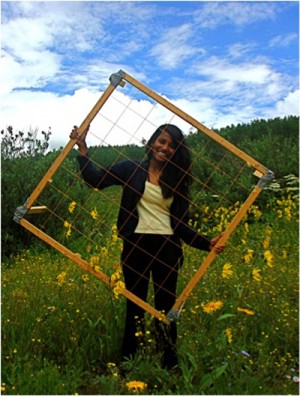
Katya Cherukumilli arrived at Cal with a calling. Having spent the first seven years of her life in the southeastern coastal state of Andhra Pradesh, Cherukumilli emphasizes, “The problem of people not being able to meet their most basic needs has always been close to my heart.” During her undergraduate years at Cal (2008-2012) as Regents’ and Chancellors’ Scholar, she majored in Environmental Sciences and minored in Global Poverty & Practice and Energy & Resources. The impacts of climate change were central to her studies and, overtime, water and sanitation challenges in developing regions became the focus of her work.
During her junior and senior year, Cherukumilli sought out a wide range of research opportunities in these fields. She worked at the Rocky Mountain Biological Laboratory, researching the impact of climate change on plant species distribution in collaboration with Professor John Harte (ESPM). Under the supervision of Professor Kara Nelson (CEE), Cherukumilli then fulfilled the “practice” component of her minor in Global Poverty through field analysis of the risks associated with water irrigation along the vegetable supply chain in the Indian city of Dharwad, Karnataka. Her concerns were as much with microbes as with social processes—“I asked myself, where is knowledge about how vegetables are irrigated lost from farm to consumption?”
Her undergraduate years culminated with participation in the Haas Scholars program. Selected among one of 20 seniors, Cherukumilli developed her climate change research with Professor Harte into a senior thesis. She describes the interdisciplinary cohort of peers and mentors as “incredible and transformative.” No other setting at Cal had offered her a context where she could expose her ideas, methods, and questions to a group of dedicated people with such a wide range of growing expertise. As she honed her research on ecological responses to climate change, her fellow Haas Scholars worked on issues of immigration law, gender equity, mental health challenges for veterans, and more. The weekly dialogues were rigorous and mind-opening. “You just don’t see this kind of interdepartmental collaboration enough here,” says Cherukumilli.
This point of interdisciplinary collaboration for social progress gets at the heart of what Cherukumilli sees as Berkeley’s greatest educational promise—what many call “the Berkeley difference.” When she made the choice to pursue her doctorate here in the Department of Civil and Environmental Engineering, she knew she had to find pockets at Cal that fostered interdisciplinarity and real-world problem solving. One place she found this intersection was at the Blum Center for Developing Economies. Cherukumilli’s first exposure to the Blum Center was through the Global Poverty & Practice minor. She met her current doctoral advisor, Professor Ashok Gadgil, when he spoke about his work on the Darfur Cook Stove Project for the Blum Center course “Global Poverty: Hopes and Challenges in the New Millennium” (GPP 115).
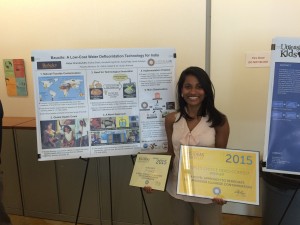
As a doctoral student in Gadgil’s Lab, Cherukumilli notes that two Blum Center affiliated programs are giving her a chance to amplify the impact of her research. During the spring of 2015, Cherukumilli teamed up with four other Cal graduate students to earn second place in the global health category of the annual Big Ideas@Berkeley competition. Their winning idea emanates from Cherukumilli’s doctoral research; the team is setting out to develop a bauxite-based defluoridation technique for communities whose water source has dangerously high levels of fluoride. The impacts could be massive. According to the Swiss Federal Institute of Aquatic Science and Technology, approximately 200 million people are regularly consuming water with levels of fluoride that dangerously exceed World Health Organization standards (1.5 mg/L (ppm)). Fluoride naturally occurs in many aquifers, but exposure to high fluoride levels can cause detrimental health effects, including anemia and skeletal fluorosis. While de-fluoridation techniques already exist on the market, Cherukumilli’s team aims to significantly reduce the cost and environmental impact of current processes. In July 2015, the project got additional recognition when it earned first place in UC Irvine’s Designing Solutions for Poverty Contest.
Cherukumilli is quick to note that the strength of her defluoridation project resides in the interdisciplinary character of her team. Her partners at Cal include a political science doctoral student and three MBAs—one of whom is also pursuing a public health degree. Cherukumilli notes that Big Ideas created a structured and incentivized forum through which they could apply their shared interests and build upon their diverse skills. While her focus is on technical design, her team members are conducting partnership development, field-testing, marketing, fundraising, and evaluation.
Cherukumilli says she yearns for there to be more curricular and co-curricular spaces at Cal where students—undergraduate and graduate alike—can come together to research and directly engage with pressing social problems. She’s found one such place in the newly launched “designated emphasis” in Development Engineering (Dev Eng) for graduate students. The Dev Eng program, which launched in fall 2014, provides course work, research mentoring, and professional development to students seeking to develop, pilot, and evaluate technological interventions for improving life in low-income settings. Cherukumilli is part of the inaugural cohort of students and faculty forging this emergent discipline. The core course, Dev Eng C200, is taught by Professors Alice Agogino (Mech Eng) and David Levine (Haas Business) and draws students from computer science, public health, city and regional planning, economics, information studies, and more.
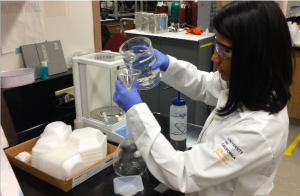
For Cherukumilli, the Dev Eng context is ideal because, “confronting these problems from the technical side, I’ve already come to understand how deeply interdisclipinary they are—issues of local context, people, politics, and education. Dev Eng structures a space where this complexity can be explored.”
During the summer of 2015, Cherukumilli was busy in the lab, advancing her research on bauxite. In the years ahead, as she completes her Ph.D., she will look to continue her work at a national lab, in a university context, or in the nonprofit sector. Wherever she ends up, it’s clear she’ll carry with her the Berkeley difference—the rigorous analytic capacity to see the complexity of daunting social problems and have the resolve to implement possible solutions.
Ticora Jones: The Federal Government Scientist for Global Development
http://dil.berkeley.edu/ticora-jones-the-federal-governments-scientist-for-global-development/
GridWatch: Using Cell Phone Sensors to Detect Power Outages
Big Ideas@Berkeley Winners Visualize an End to Cervical Cancer
By Carlo David
Prompted by funding and recognition from the Big Ideas@Berkeley contest, a group of Cal students headed by Mechanical Engineering graduate student Julia Kramer is seeking to establish a sustainable training program called “Visualize” for midwives in Ghana. In a country where only five percent of women have been screened for cervical cancer, Visualize aims to create a system in which midwives receive the essential skills and tools to perform a visual inspection of the cervix with acetic acid (vinegar). The inspection method, known as VIA, is a low-cost and effective way to screen for cervical cancer, but it is not widely used in Ghana and other countries due to a lack of training and awareness.
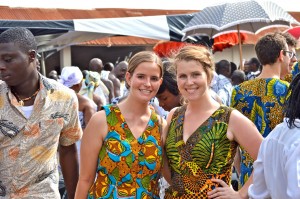
Kramer and Maria Young first conceived of the project as undergraduates at the University of Michigan. “We were part of a group of five engineering students who spent eight weeks in Ghana for a cultural immersion and design ethnography experience,” said Kramer.
At Michigan, she and her collaborators developed the first few prototypes of a VIA training simulator, based on design requirements they developed at two major teaching hospitals in Ghana. At Berkeley, Kramer teamed up with fellow Mechanical Engineering and Haas School of Business students Abhimanyu Ray, Karan Patel, and Betsy McCormick, to develop the midwife VIA training concept. Visualize’s faculty advisors include public health professional Kyle Fliflet and Mechanical Engineering Professor Alice Agogino, who is chair of the Development Engineering graduate group.
Kramer explains that her project was motivated largely by interactions with midwives, nurses, and doctors in Ghana, along with substantial data supporting the need for more cervical cancer screening. Annually and worldwide, 275,000 women die from cervical cancer. Eighty percent of deaths occur in developing countries, which often do not have the medical infrastructure to diagnose and treat cervical cancer. VIA has been proven to serve as a low-cost alternative to methods like the Pap smear. A 2008 International Journal of Gynecology & Obstetrics study found that VIA could reduce mortality rates by 68 percent. Through midwife-administered VIA tests and subsequent treatments, the Visualize team estimates it can avert 150,000 deaths per year.
Based on their experiences in Ghana, Kramer and her colleagues believe midwives, rather than doctors or other medical professionals, are the best means to implement their public health solution. “Midwives have and can be trained for this procedure,” said Agogino. “As a matter of fact, because such an intimate procedure requires interpersonal communication skills, midwives are better suited than licensed medical doctors.”
The VIA method is not only cheaper than a Pap smear—if properly performed, it also can be equally effective. The method works as follows: a midwife performs a preliminary pelvic examination; she inspects any pre-existing abnormalities; she applies a small amount of table vinegar in the cervix; if acetowhite lesions appear, cancerous cells may be at work.
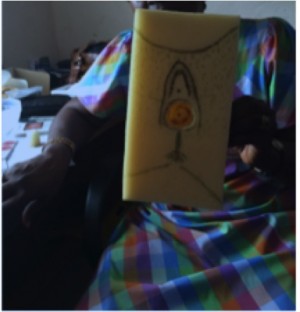
If there are signs of pre-cancerous cells, the midwife may perform cryotherapy, a procedure that freezes off cervical abnormalities and eradicates cancer cells. In a 15-year controlled trial of 151,000 women ages 35-64 in Mumbai, India, the mortality rate in the cryotherapy treatment group was reduced by 31 percent.
There are, however, unique challenges and financial hurdles to implementing Visualize. According to Agogino, “One of the biggest challenges is identifying infrastructures that already exist for training midwives, so the midwives can eventually train other women in Ghana.” Indeed, the Visualize team is exploring whether it is viable to incentivize women to recruit and train other women, particularly to reach remote areas.
Communication may also be a challenge for Kramer and her team. “There’s an ever-present challenge of working in a culture I’m not part of,” explained Kramer. “It’s hard to travel back and forth to Ghana and it’s difficult to bridge the communication gap using email or Skype.”
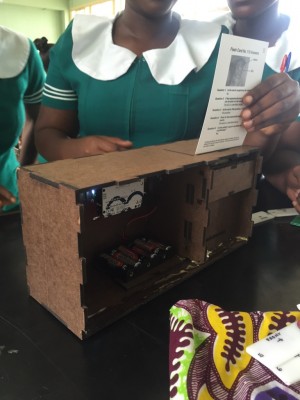
Kramer and her colleagues also must walk a fine line between American and Ghanaian public health and other cultures. “Since one of the main goals of this project is empowerment, we want to remain very careful about overstepping our bounds and ensuring mutual respect,” explained Kramer.
The Visualize team plans to use various media—television, radio, billboards—to market the availability of midwives for cervical cancer screenings. In addition, the team is collaborating with the Ghana Ministry of Health and Ghana Health Services to vet and publicize its efforts. So far, response from Ghanaian government agencies has been positive. Visualize has found several partners, including the Kumasi Nurses and Midwifery and Training College and the Ministry of Health. Its next step is to identify the location of its first training program.
Ultimately, Kramer said her project is about respectfully furthering social change. “Young people can and should take a more active role in addressing conditions of global poverty,” she said. “But we have to be humble and realistic about our role in societal progress. We have to respect cultural traditions and boundaries and be aware that our presence carries connotations beyond our control.”
The project will be running a fundraising campaign from September 14 until October 14. For more information, go here: crowdfund.berkeley.edu/
